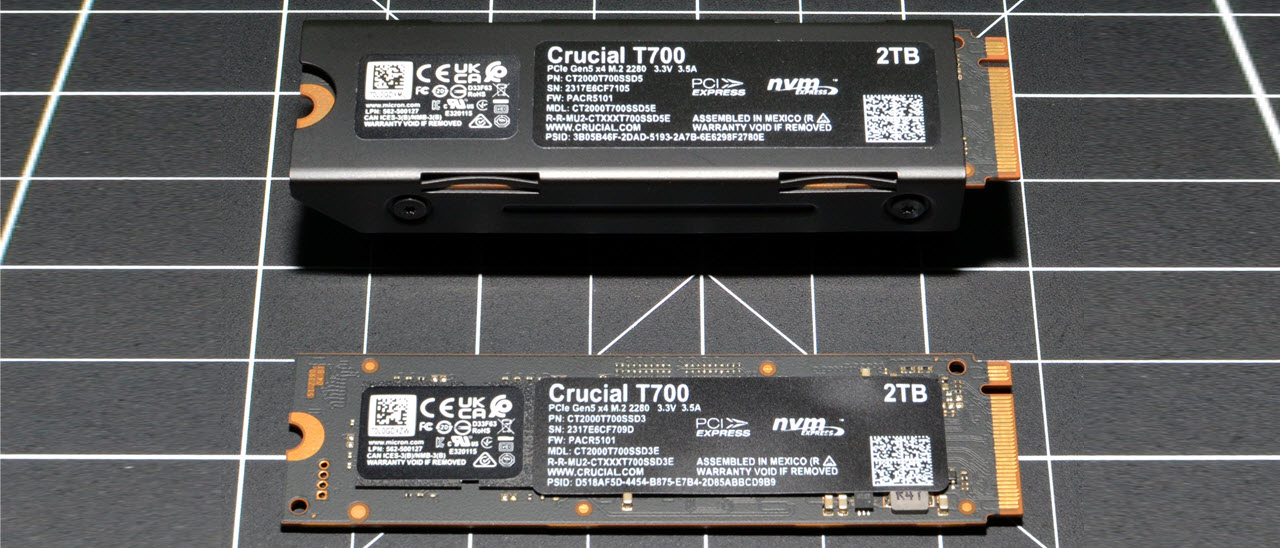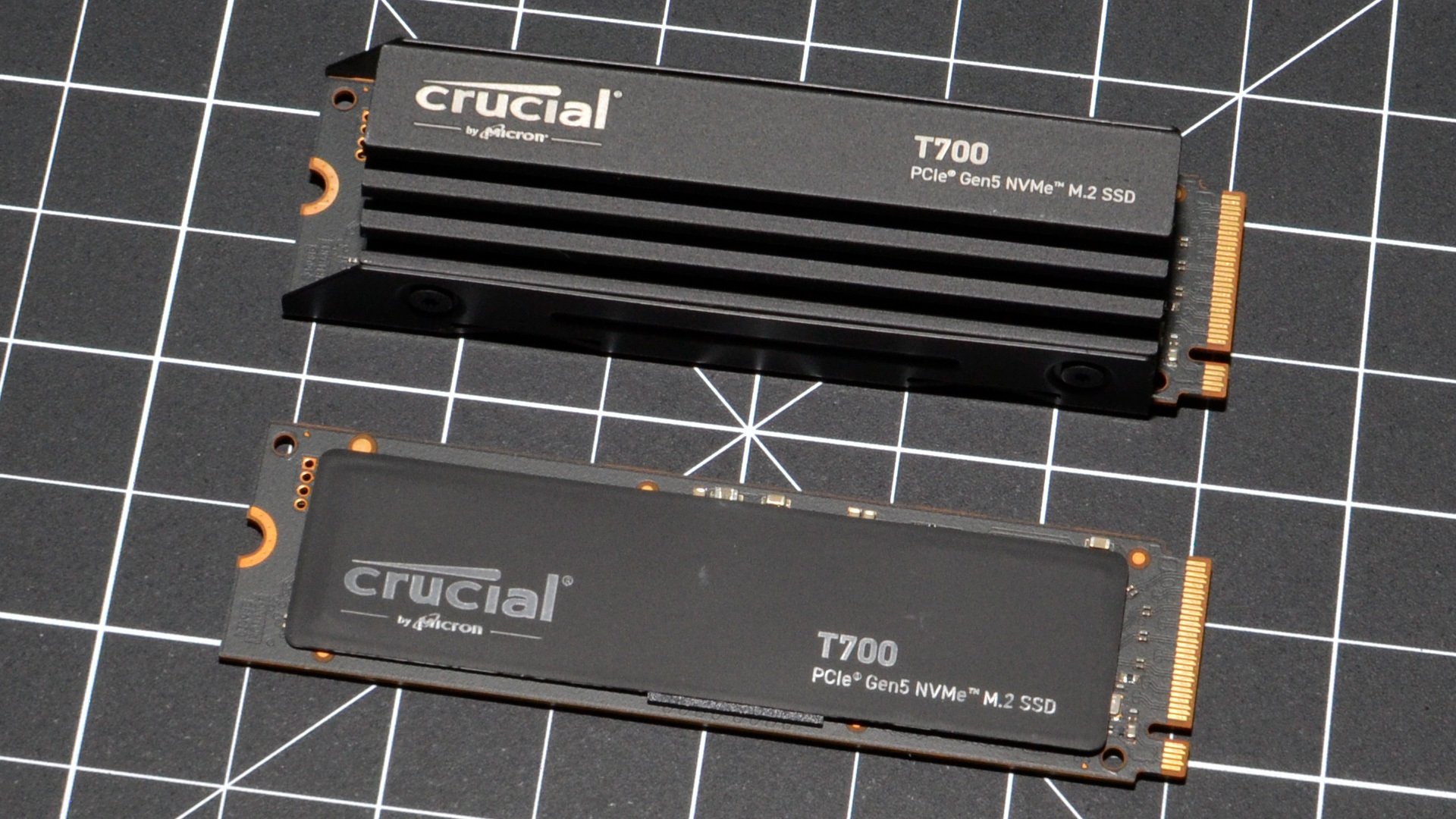Why you can trust Tom's Hardware
Comparison Products
The 2TB Crucial T700 SSD is tested both with Crucial’s heatsink (labeled "HS" in the charts) and with out Asus motherboard’s heatsink (labeled "(Mobo)" in the charts). It’s up against other current PCIe 5.0 SSDs including the Corsair MP700, the Gigabyte Aorus Gen5 10000, the Inland TD510, and we also have results from the engineering sample (ES) Phison E26. The high-end PCIe 4.0 drives in our charts include the Adata Legend 960 Max, Crucial P5 Plus, Sabrent Rocket 4 Plus-G, Samsung 990 Pro, and Solidigm P44 Pro.
Trace Testing - 3DMark Storage Benchmark
Built for gamers, 3DMark’s Storage Benchmark focuses on real-world gaming performance. Each round in this benchmark stresses storage based on gaming activities including loading games, saving progress, installing game files, and recording gameplay video streams.
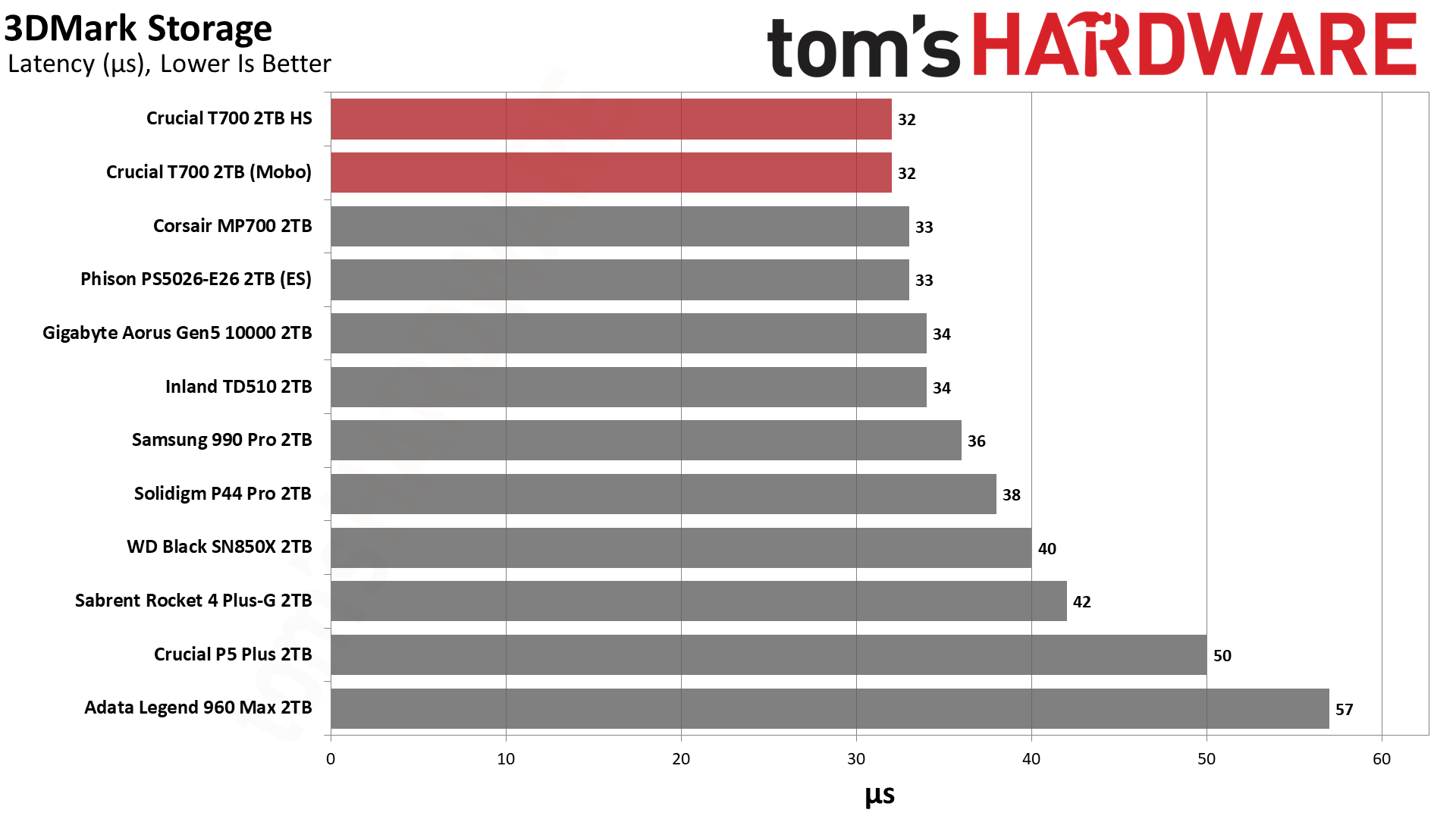
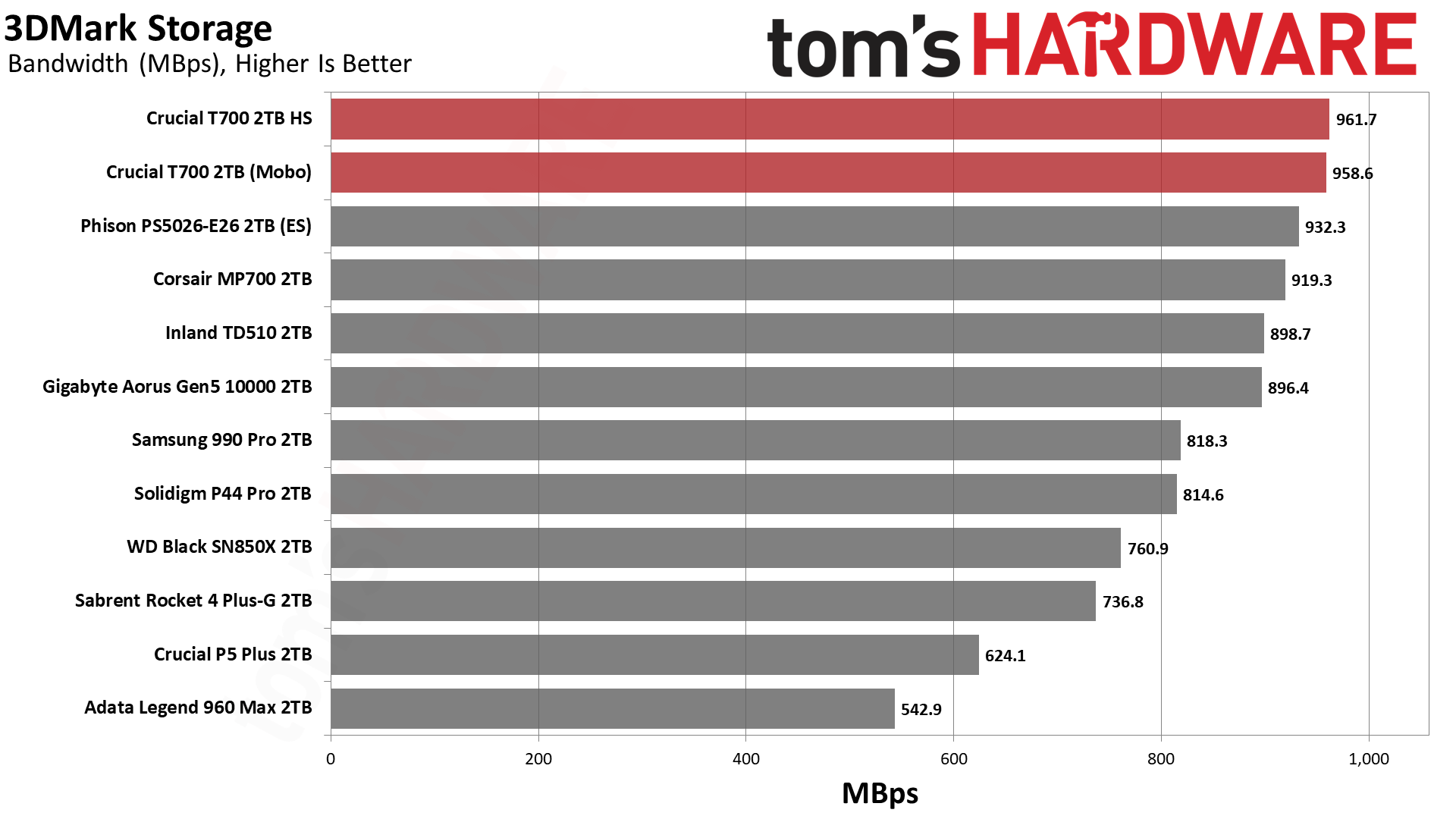
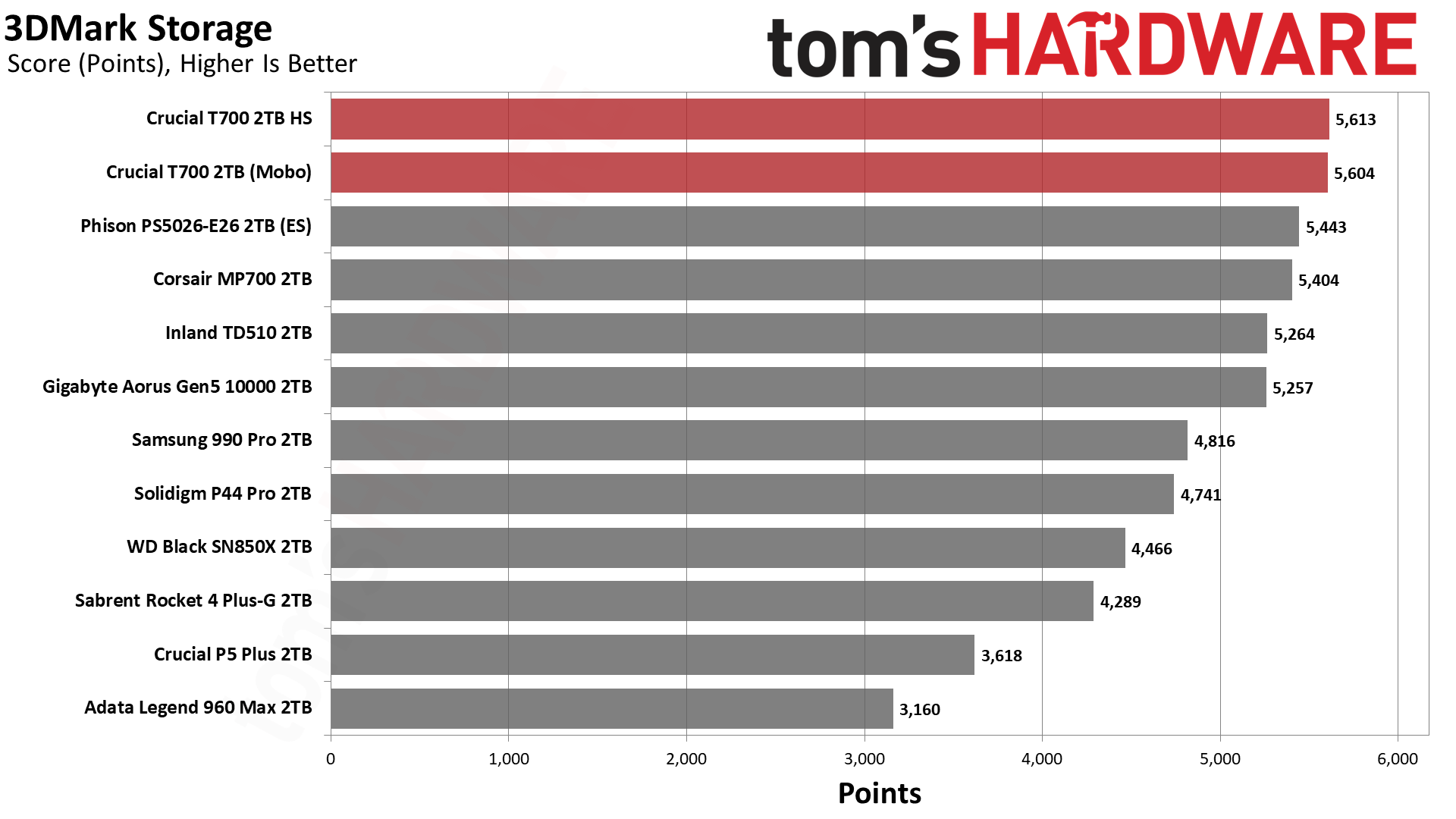
The T700 is the fastest drive we’ve tested to date in 3DMark. The performance improvement over other PCIe 5.0 SSDs is a modest 4~7 percent, with a larger gap between the T700 and leading 4.0 options.
Speaking of gaming, drives using the E26 SSD controller come with Phison’s I/O+ firmware for DirectStorage optimization, which is only available on one PCIe 4.0 SSD, the Sabrent Rocket 4 Plus-G. Faster drives should be out by the time that makes a real impact, however.
Trace Testing – PCMark 10 Storage Benchmark
PCMark 10 is a trace-based benchmark that uses a wide-ranging set of real-world traces from popular applications and everyday tasks to measure the performance of storage devices.
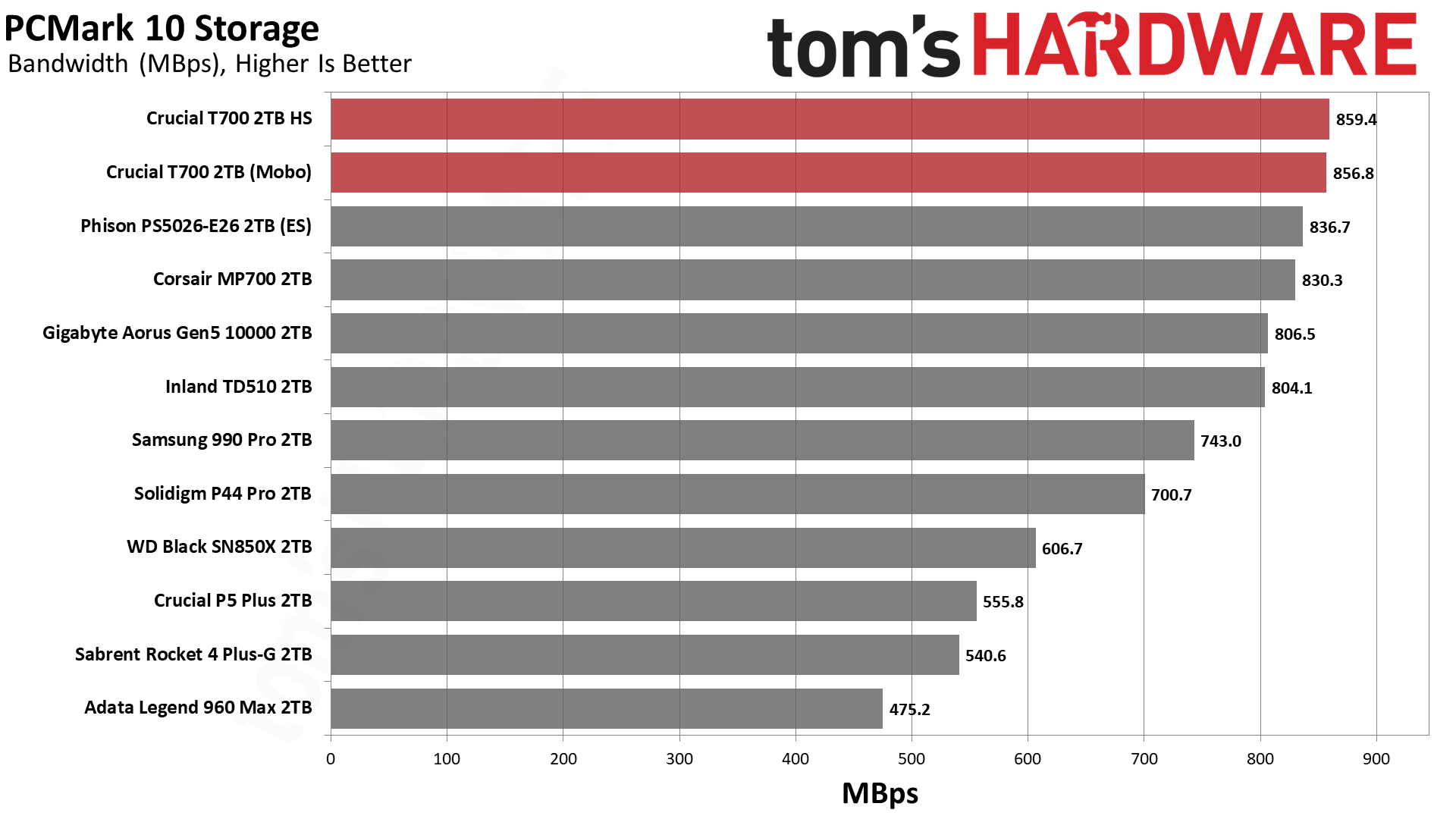
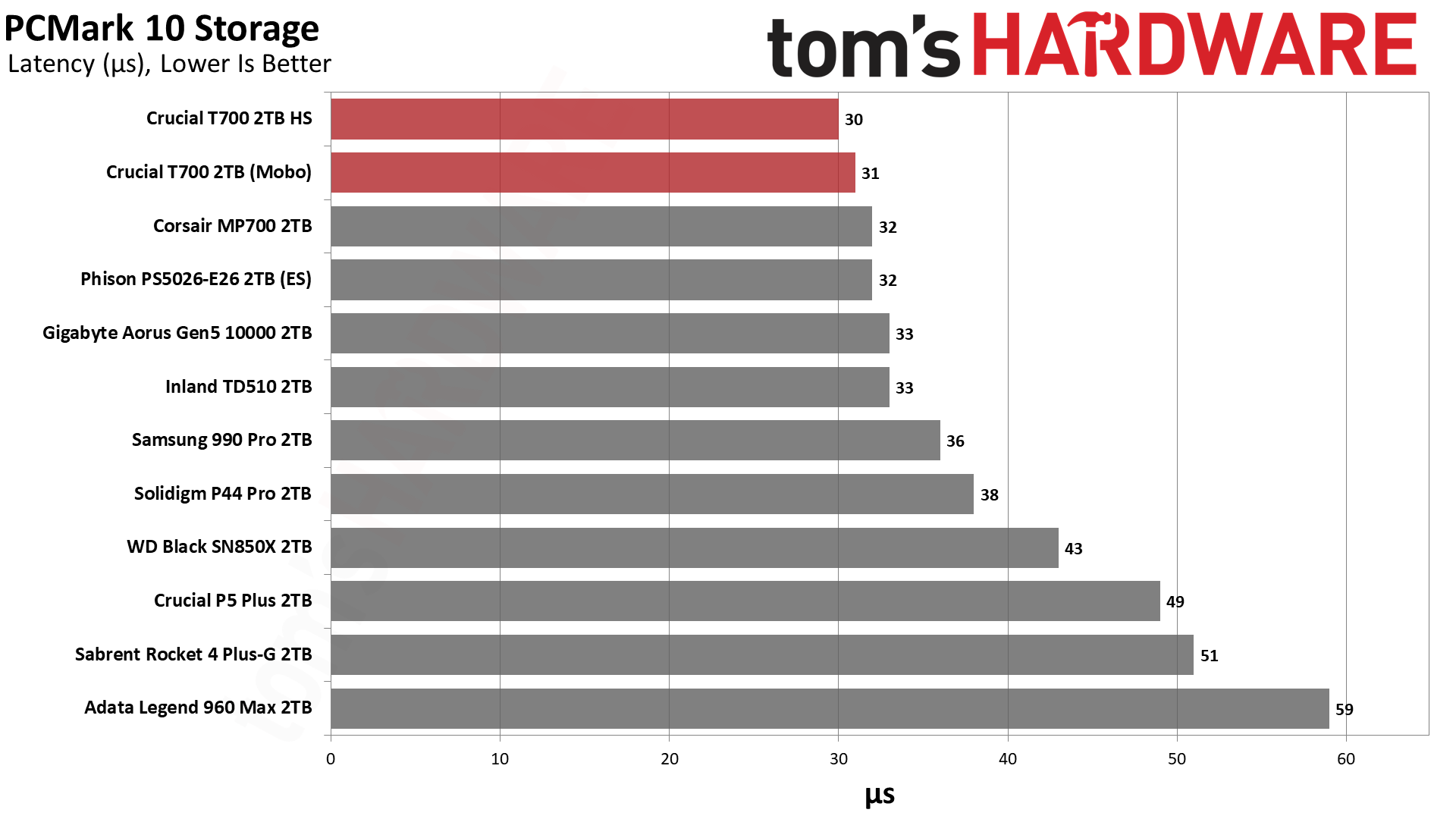
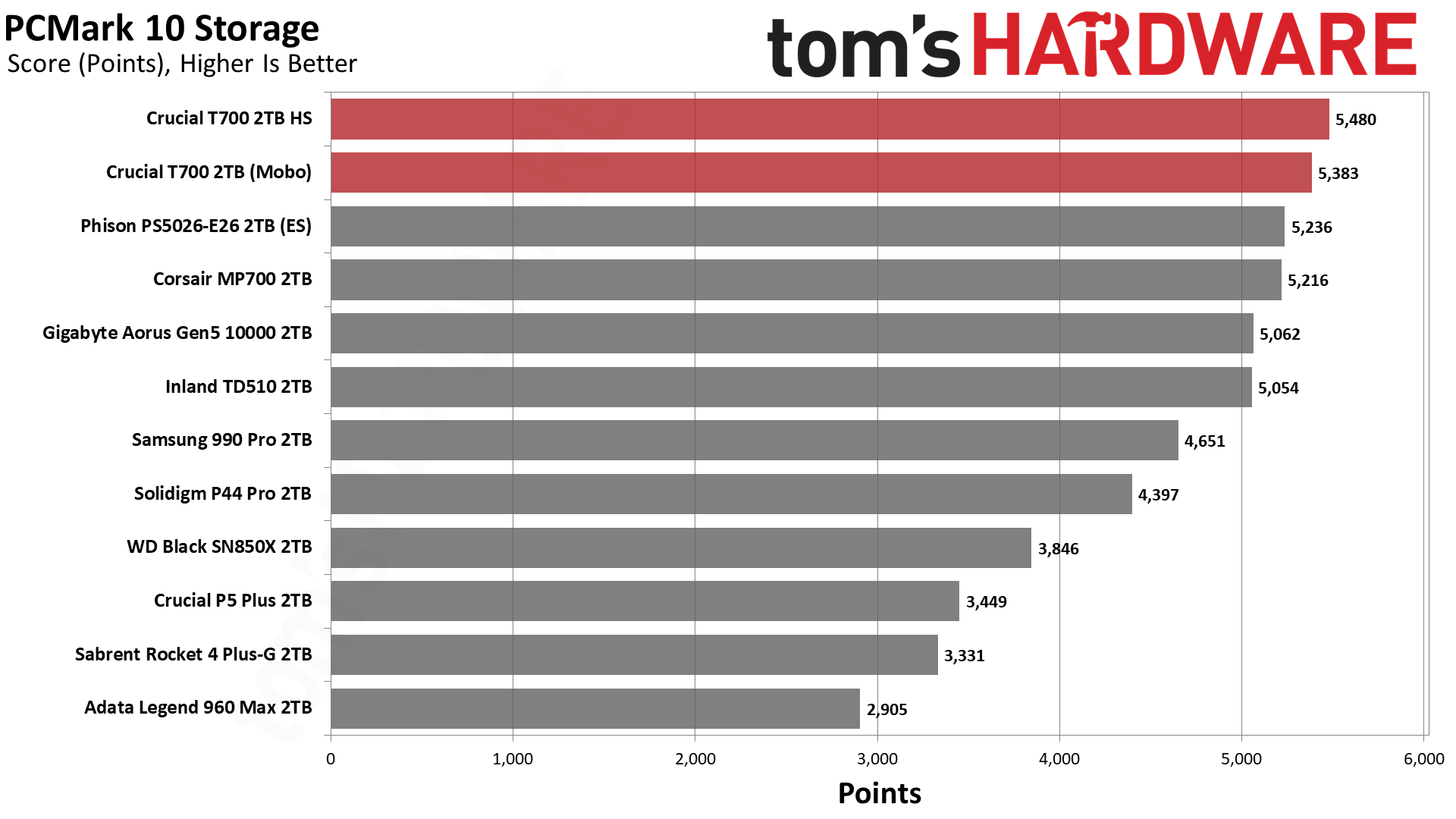
PCMark 10 shows a similar pattern with the T700 again on top. The real-world differences between the top drives are very small, especially among the PCIe 5.0 models, but the slightly higher transfer speeds do push Crucial to the top.
Transfer Rates – DiskBench
We use the DiskBench storage benchmarking tool to test file transfer performance with a custom, 50GB dataset. We copy 31,227 files of various types, such as pictures, PDFs, and videos to a new folder and then follow-up with a reading test of a newly-written 6.5GB zip file.
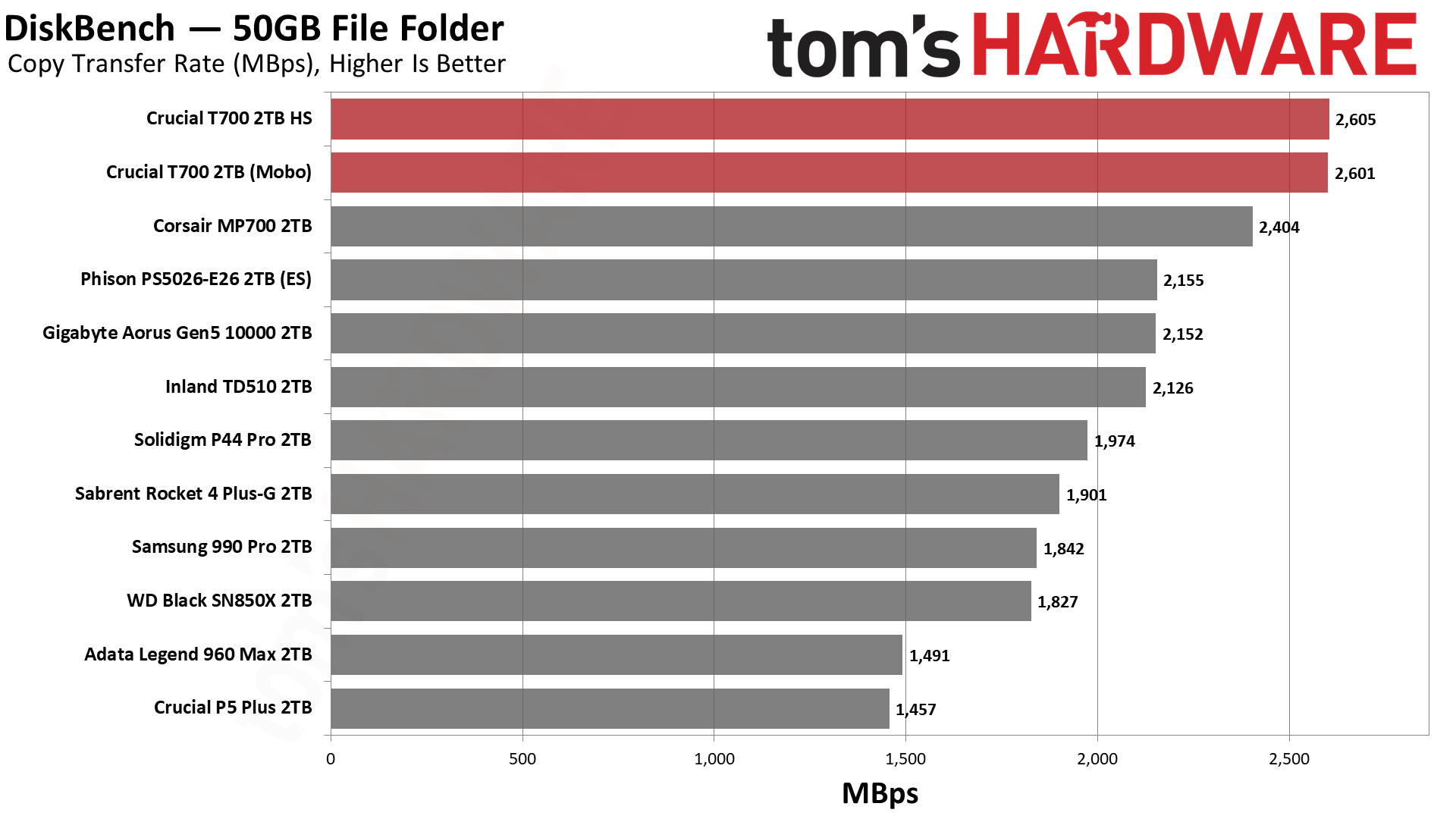
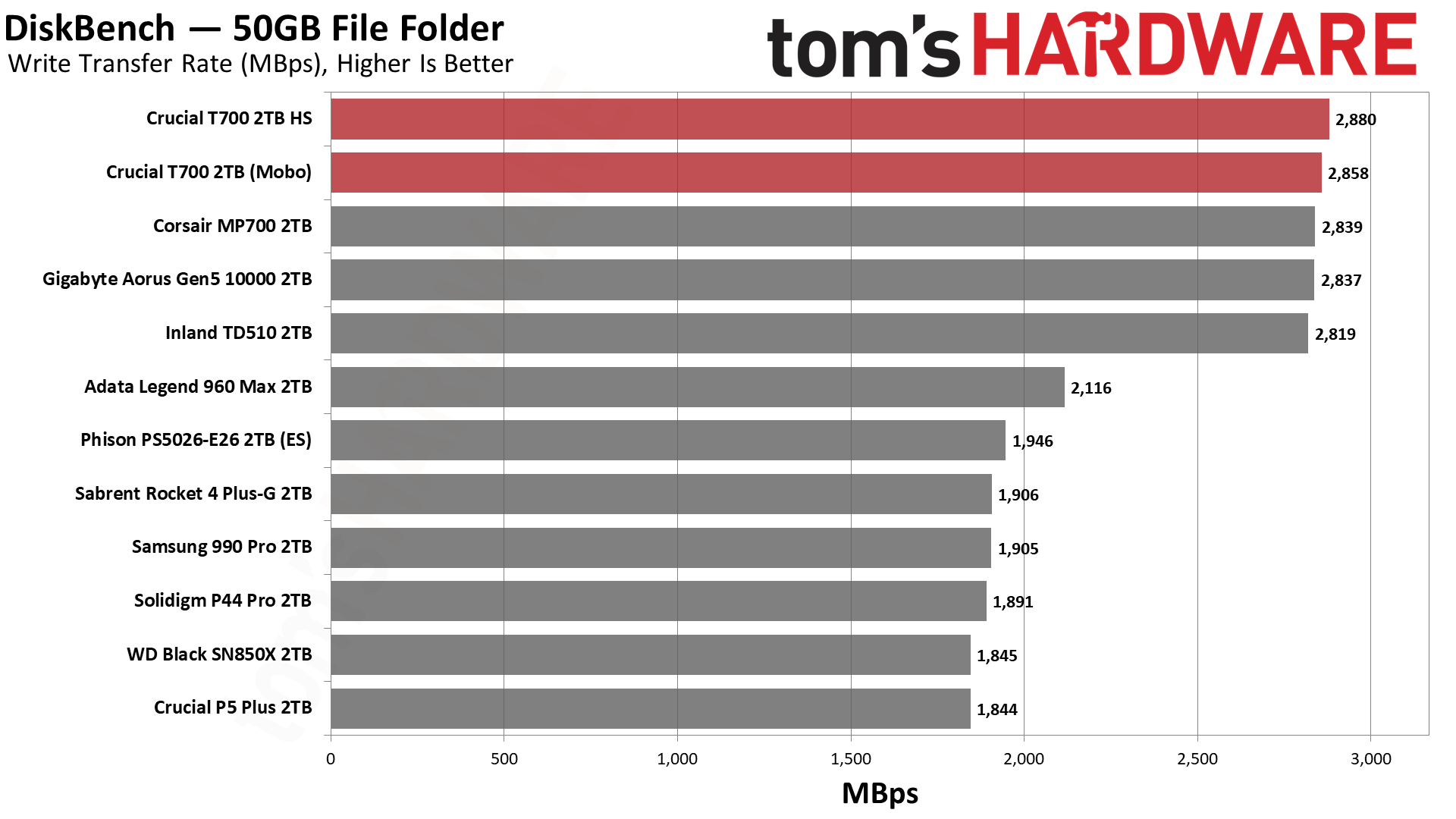
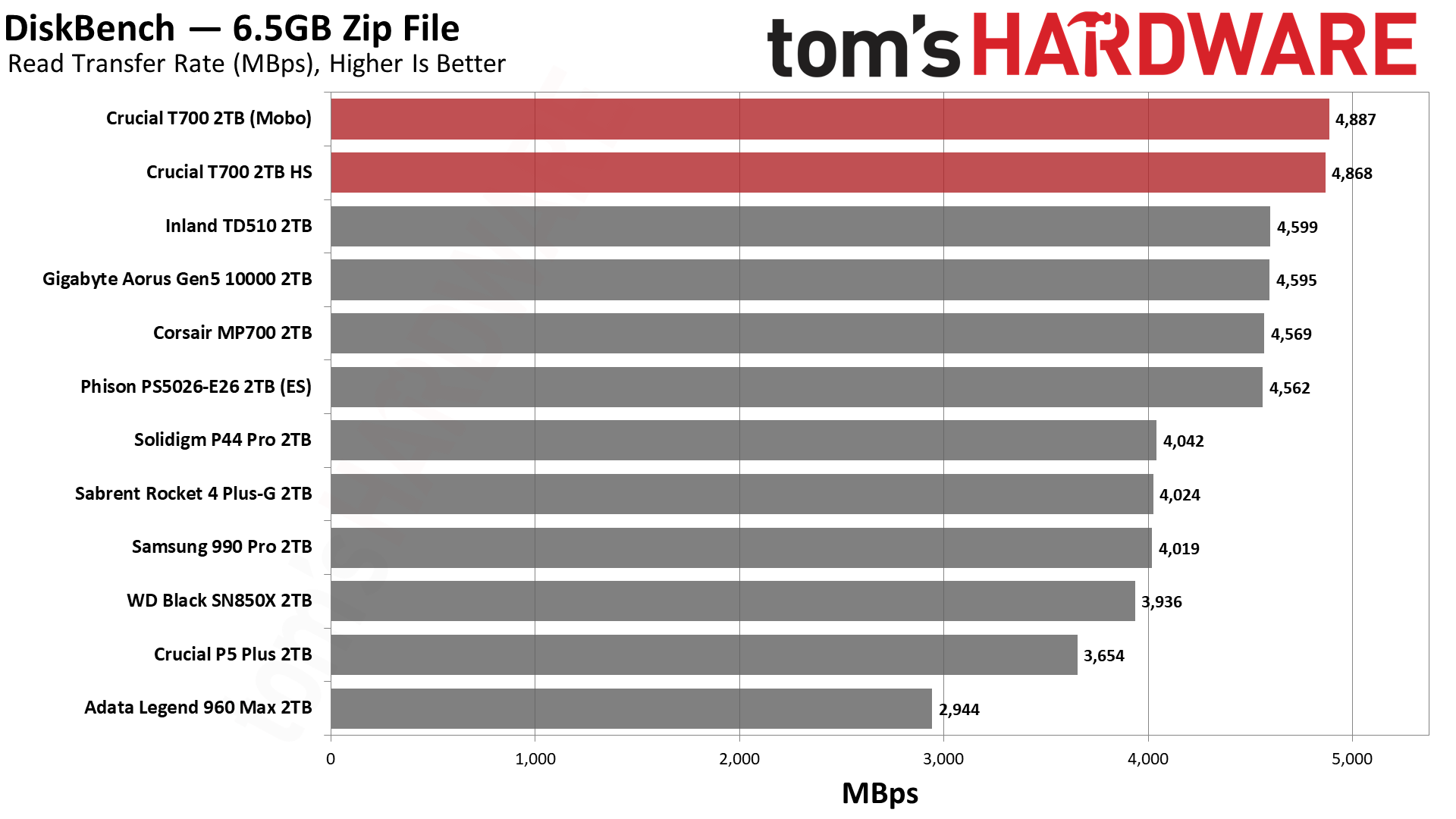
Copy speeds in DiskBench are faster, with significant gains over previously-tested drives. The main reason to buy PCIe 5.0 drives right now is for this type of performance if you are capable of making use of it — meaning, you have a Z690/Z790 or X670 class motherboard.
Get Tom's Hardware's best news and in-depth reviews, straight to your inbox.
Synthetic Testing - ATTO / CrystalDiskMark
ATTO and CrystalDiskMark (CDM) are free and easy-to-use storage benchmarking tools that SSD vendors commonly use to assign performance specifications to their products. Both of these tools give us insight into how each device handles different file sizes.
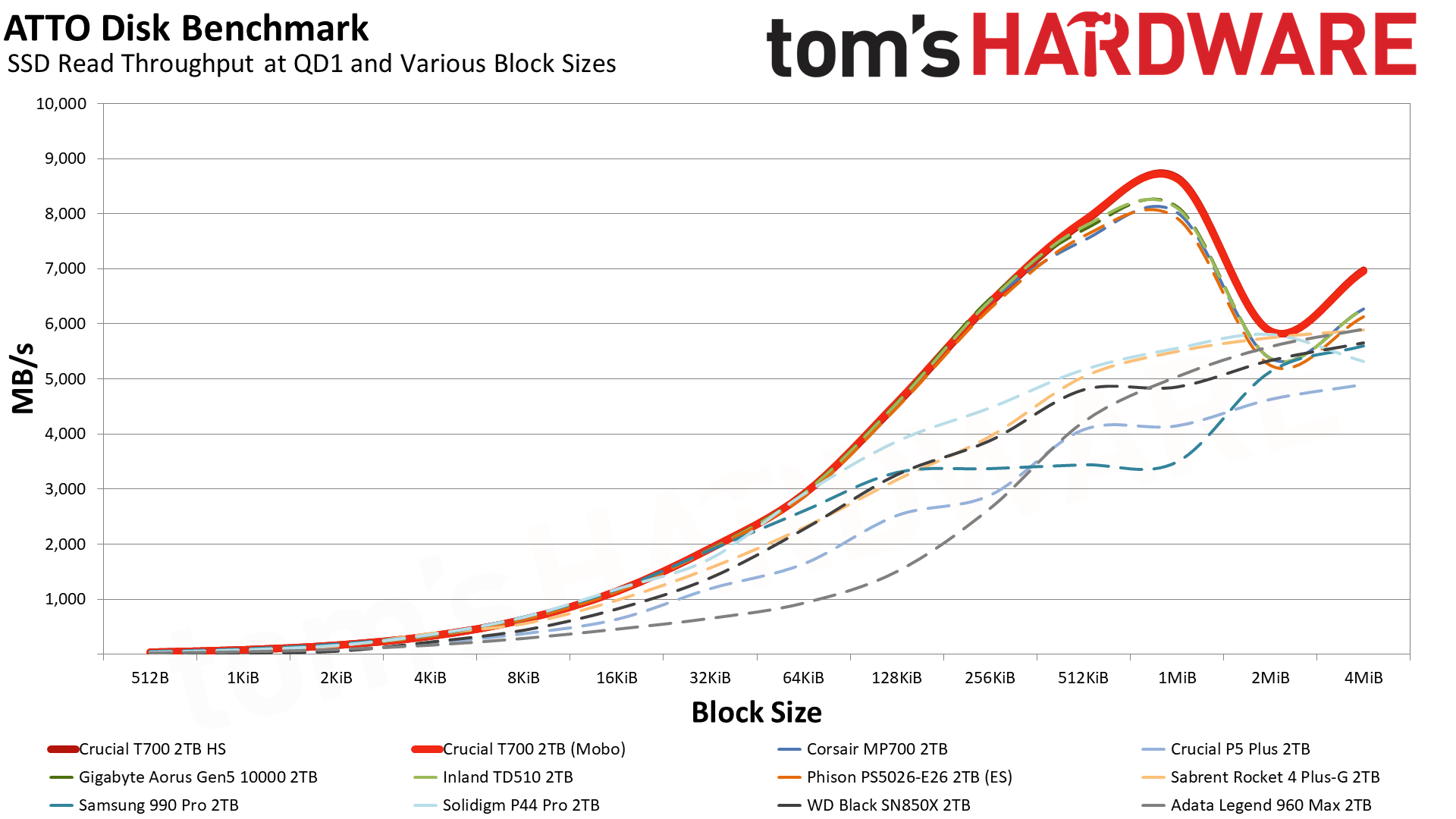
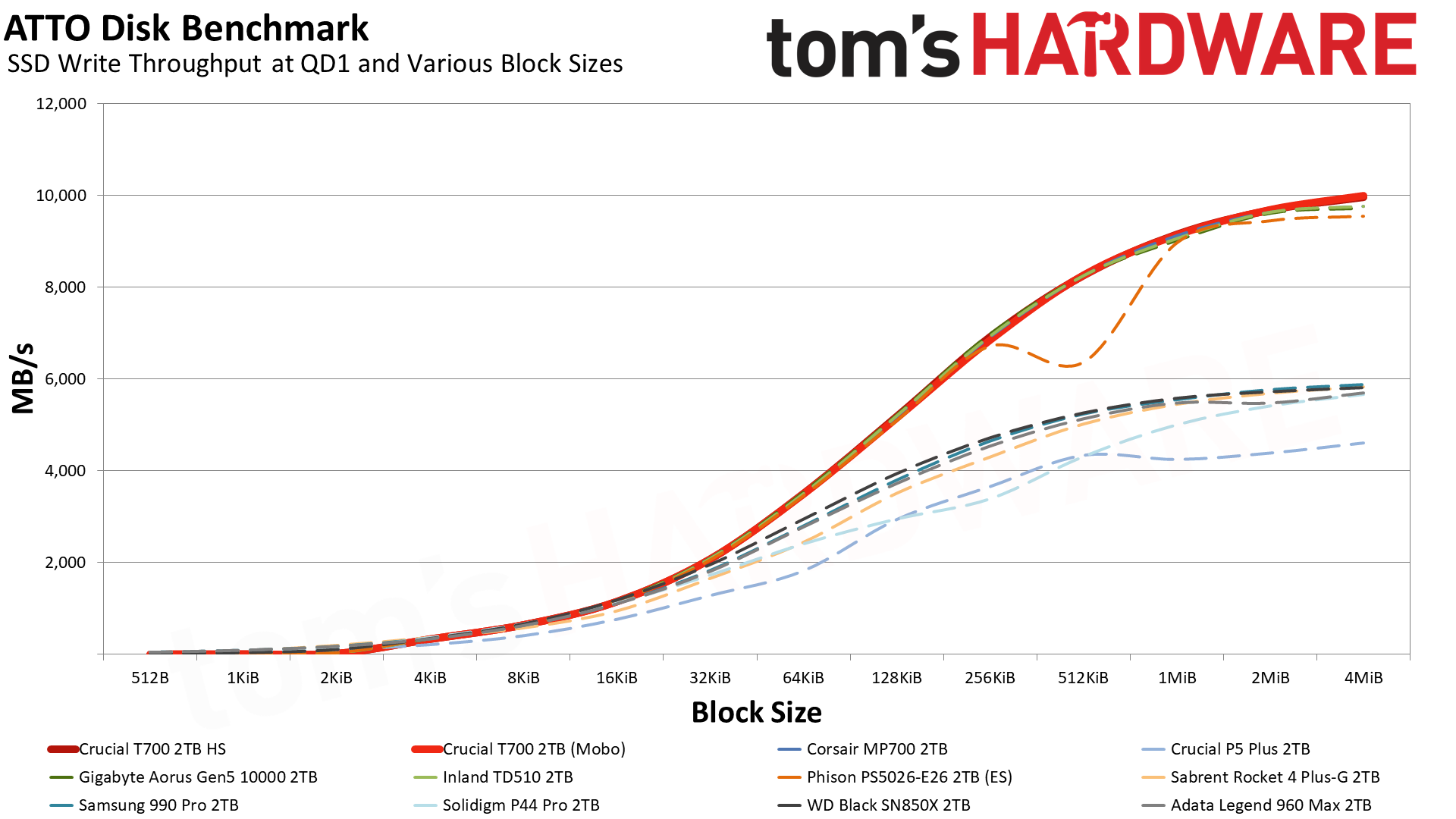
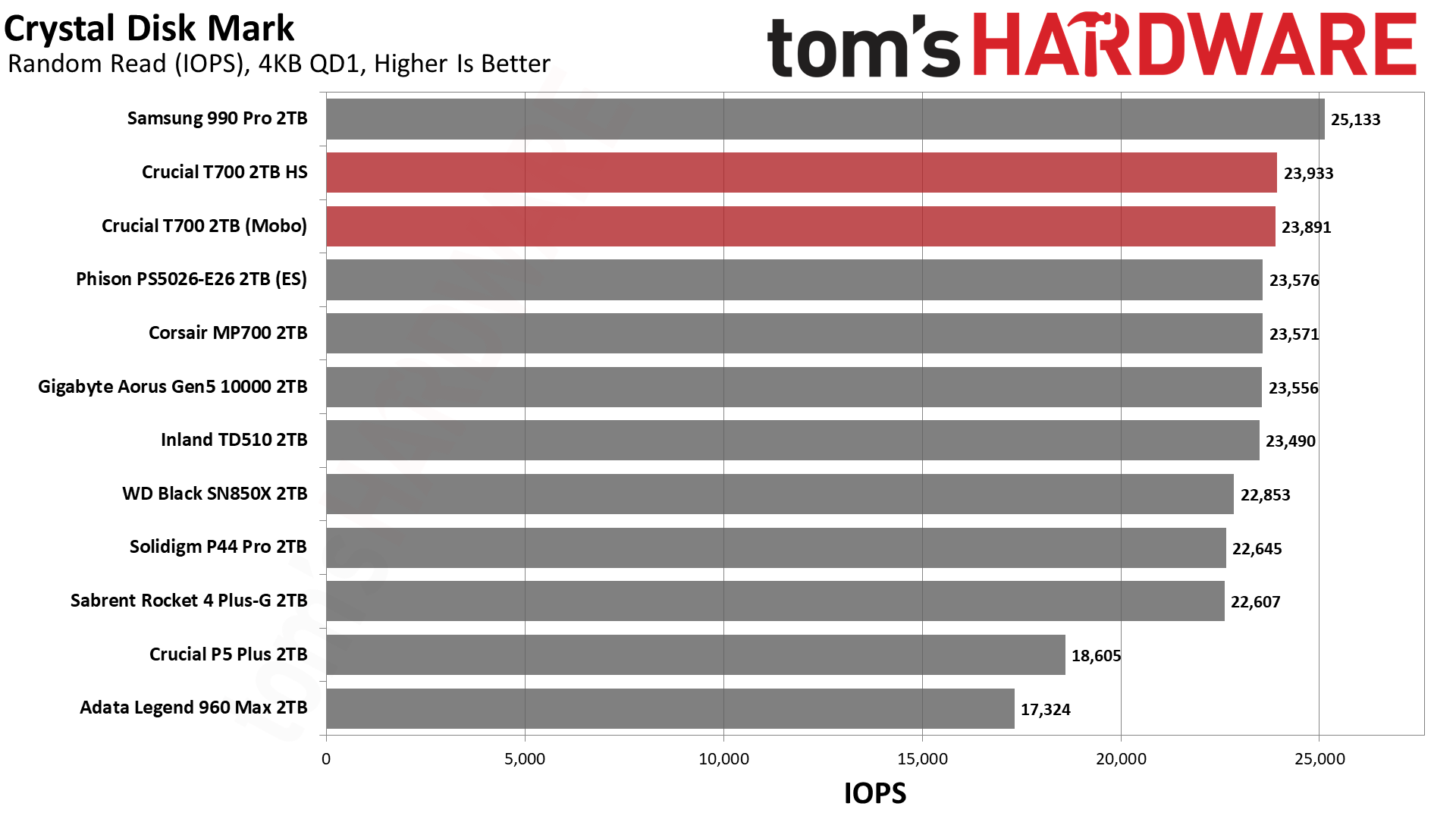
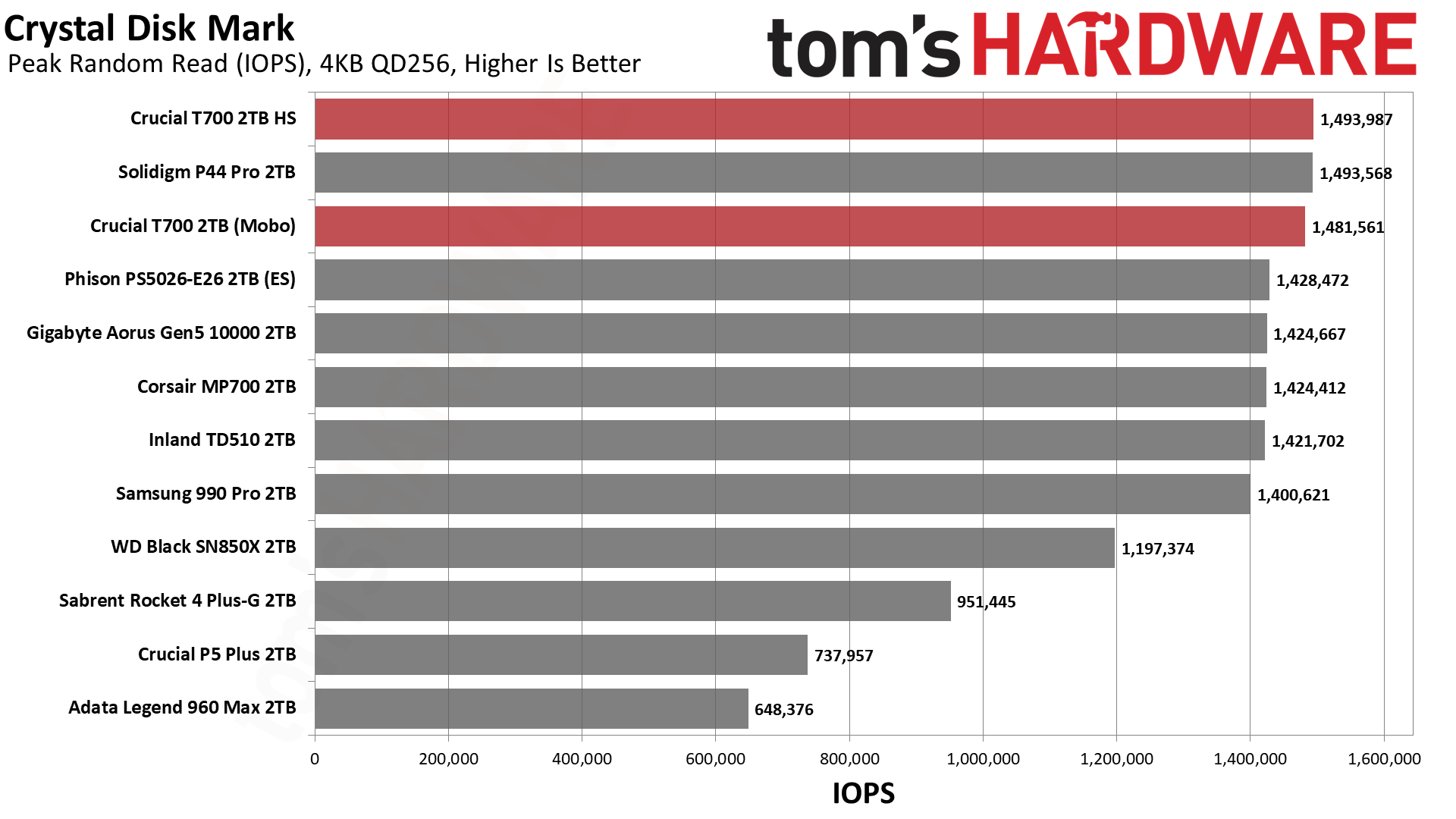
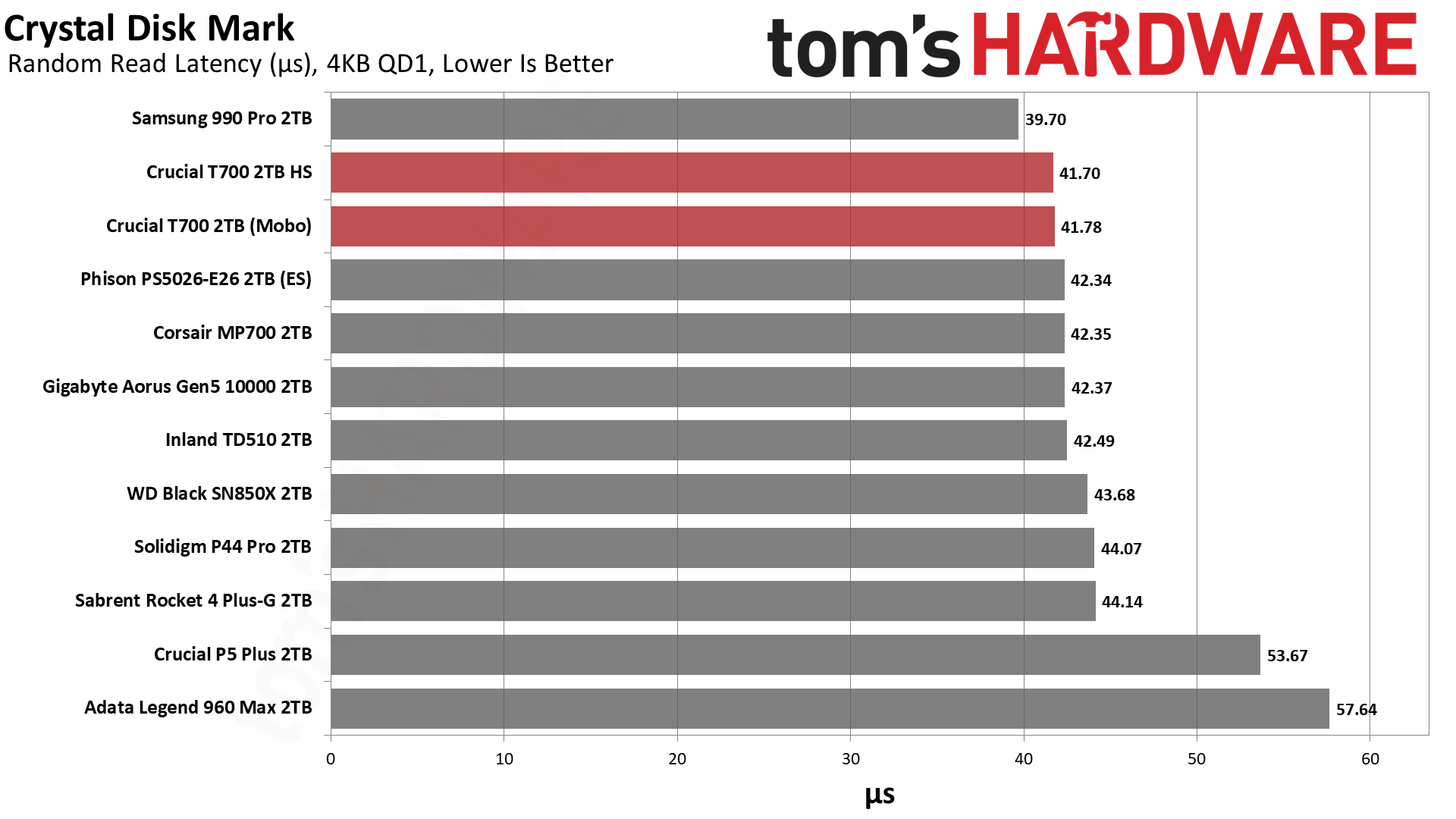
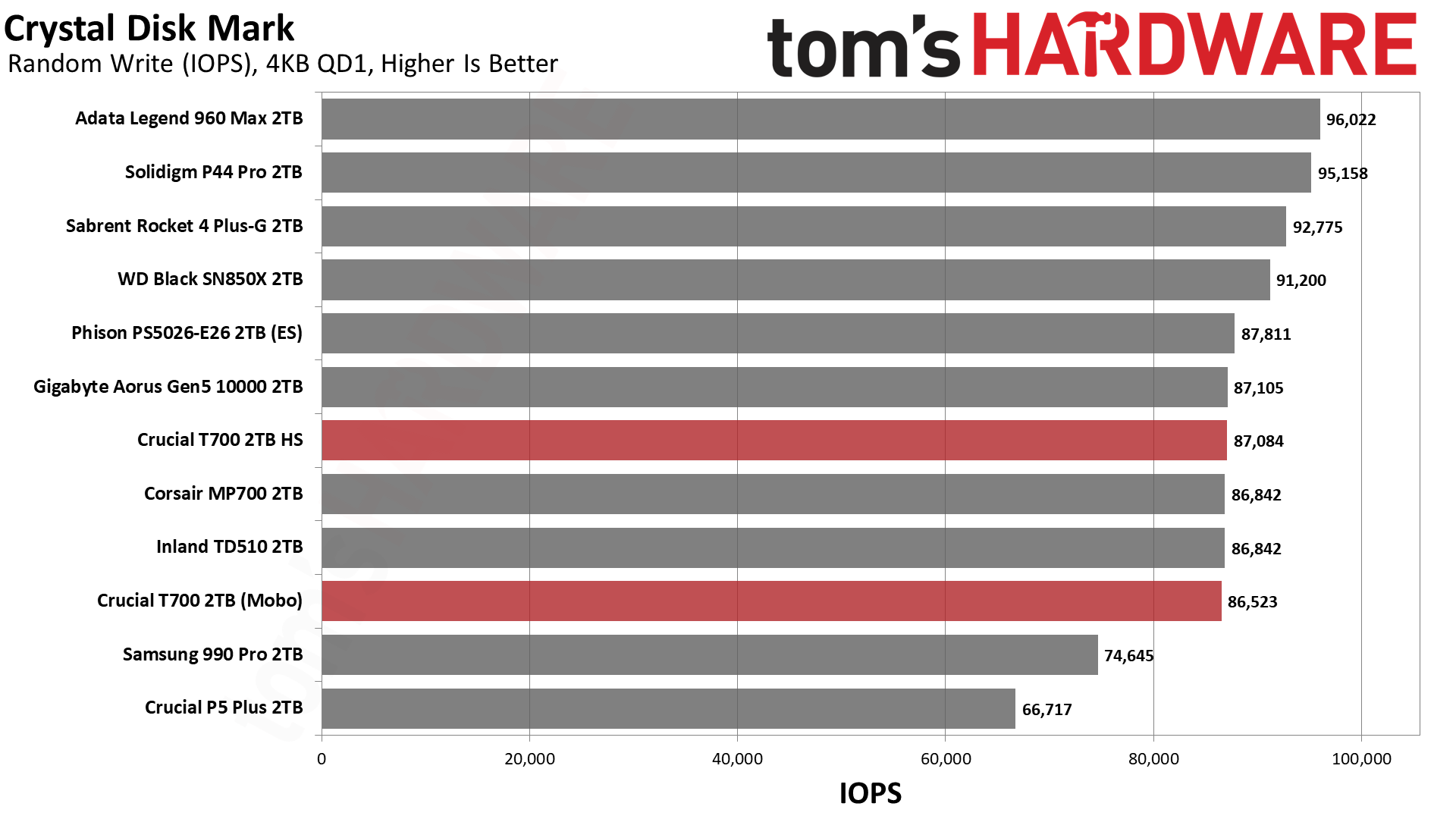
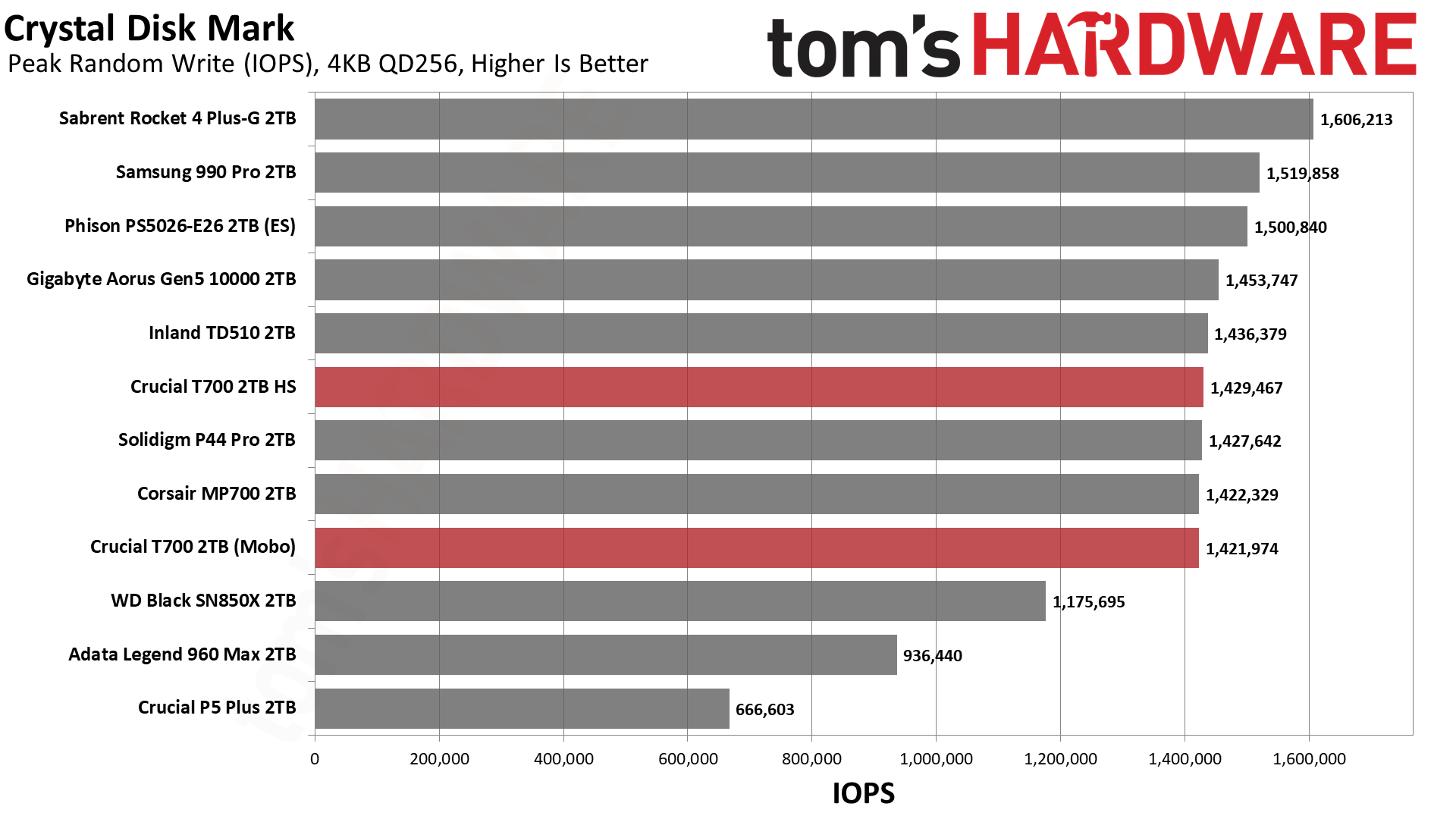
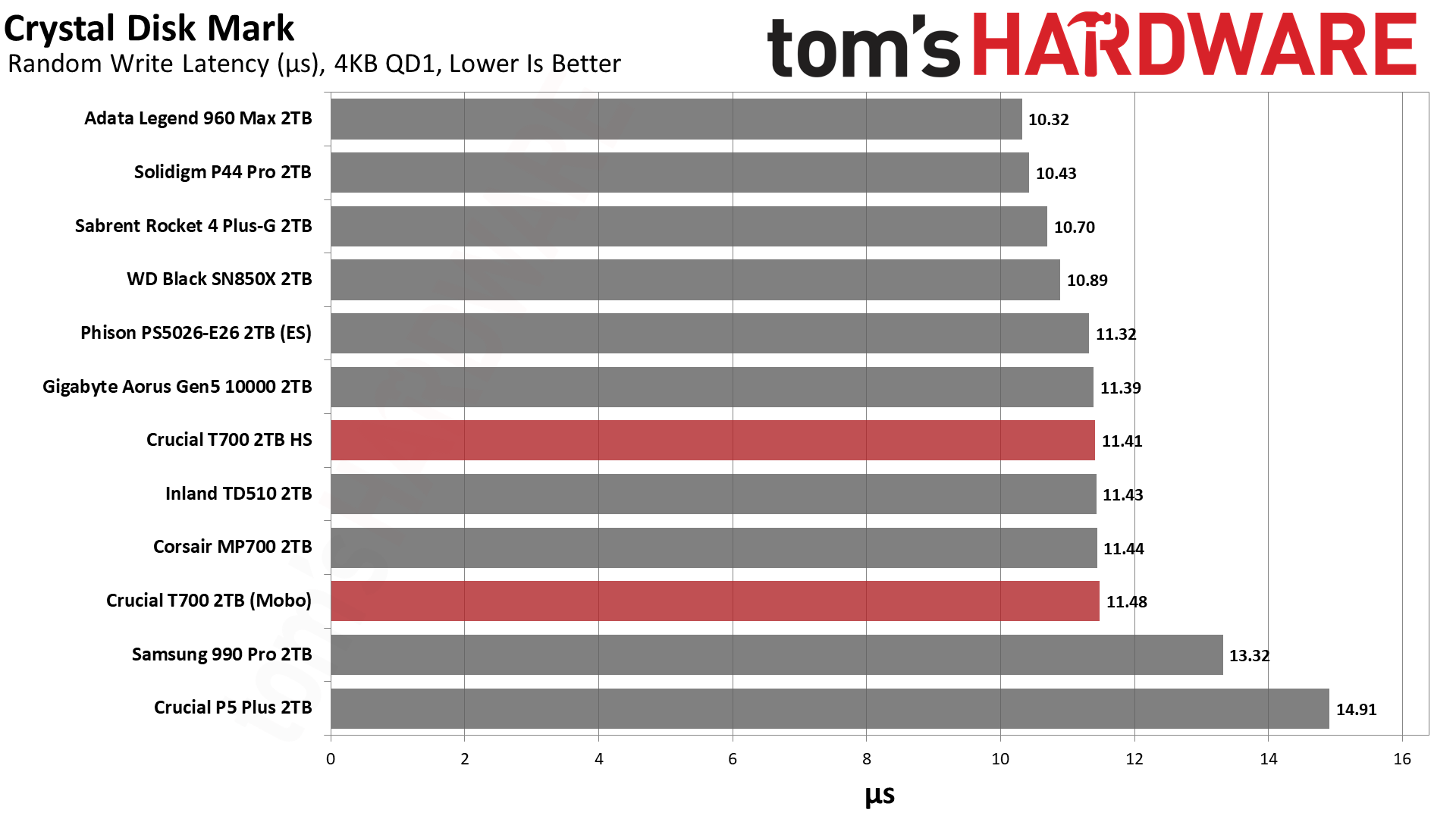
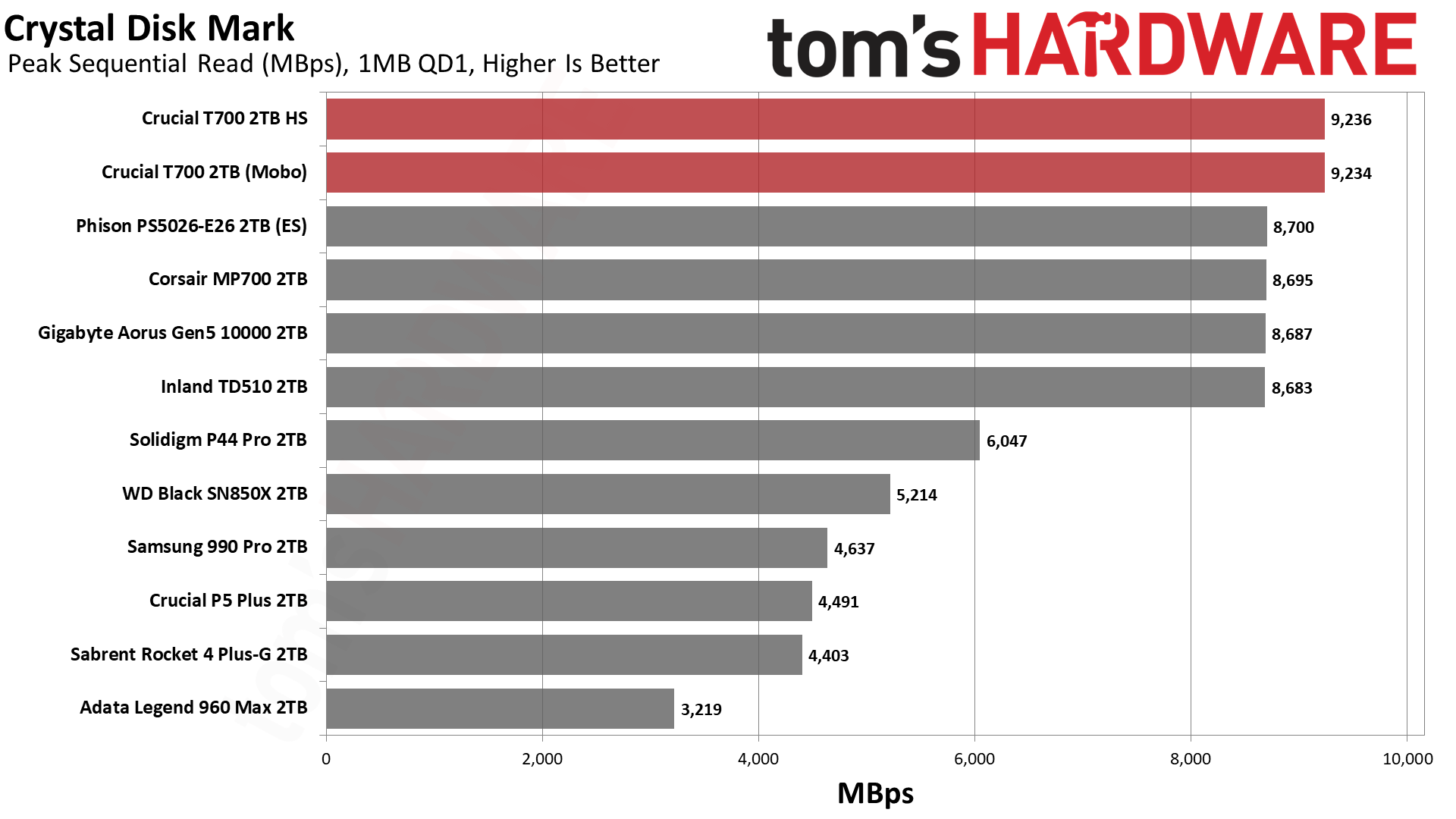
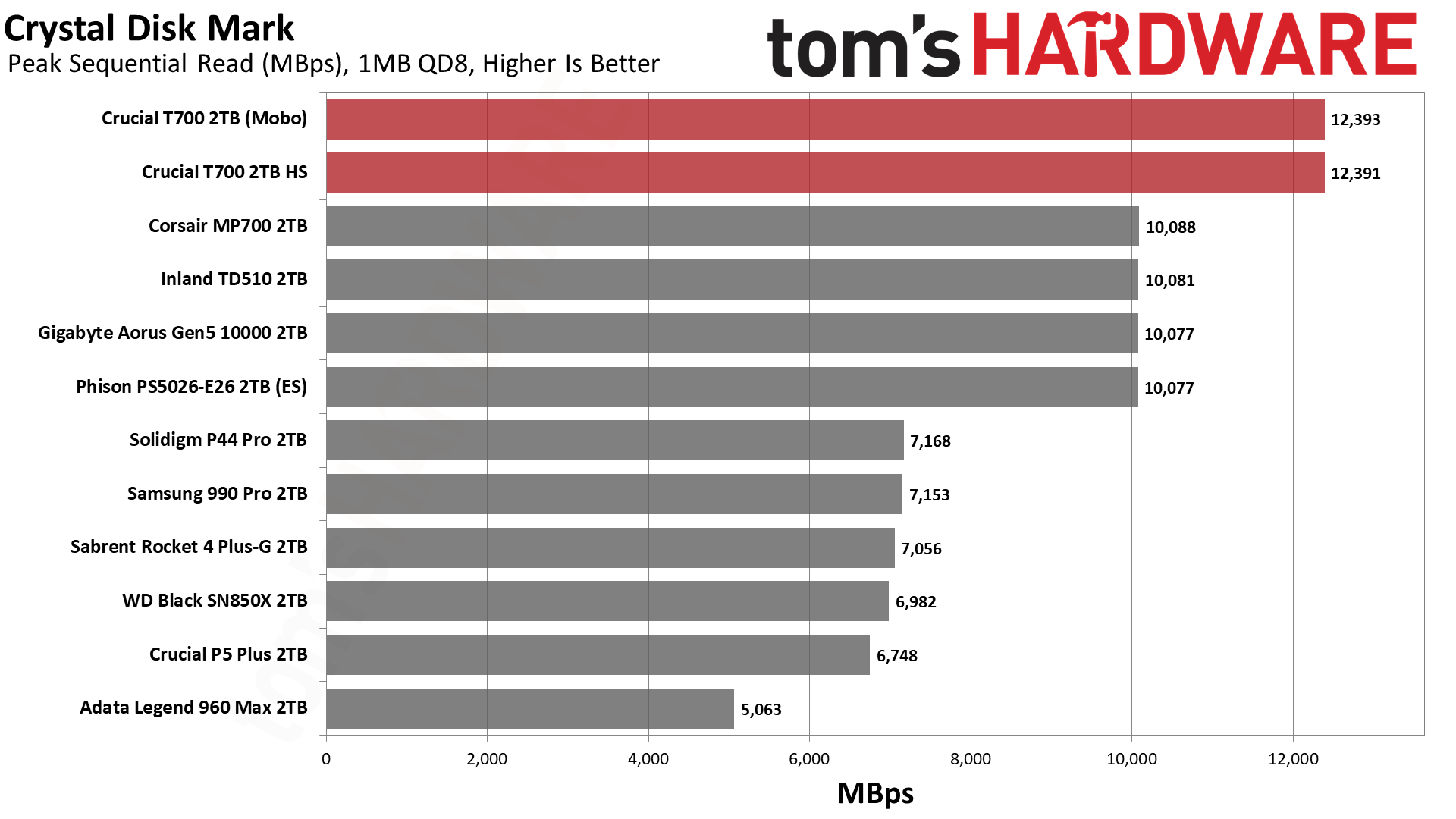
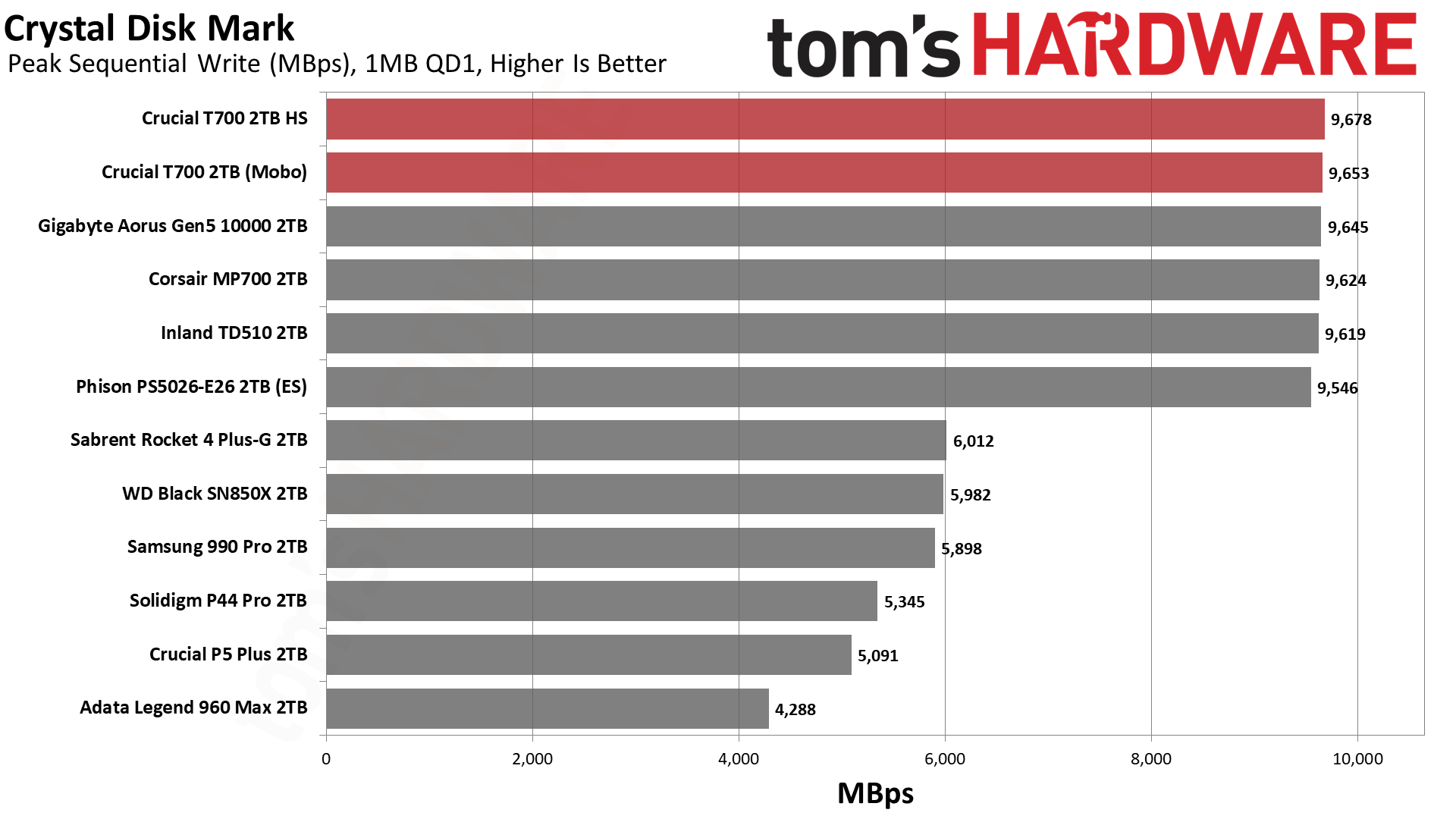
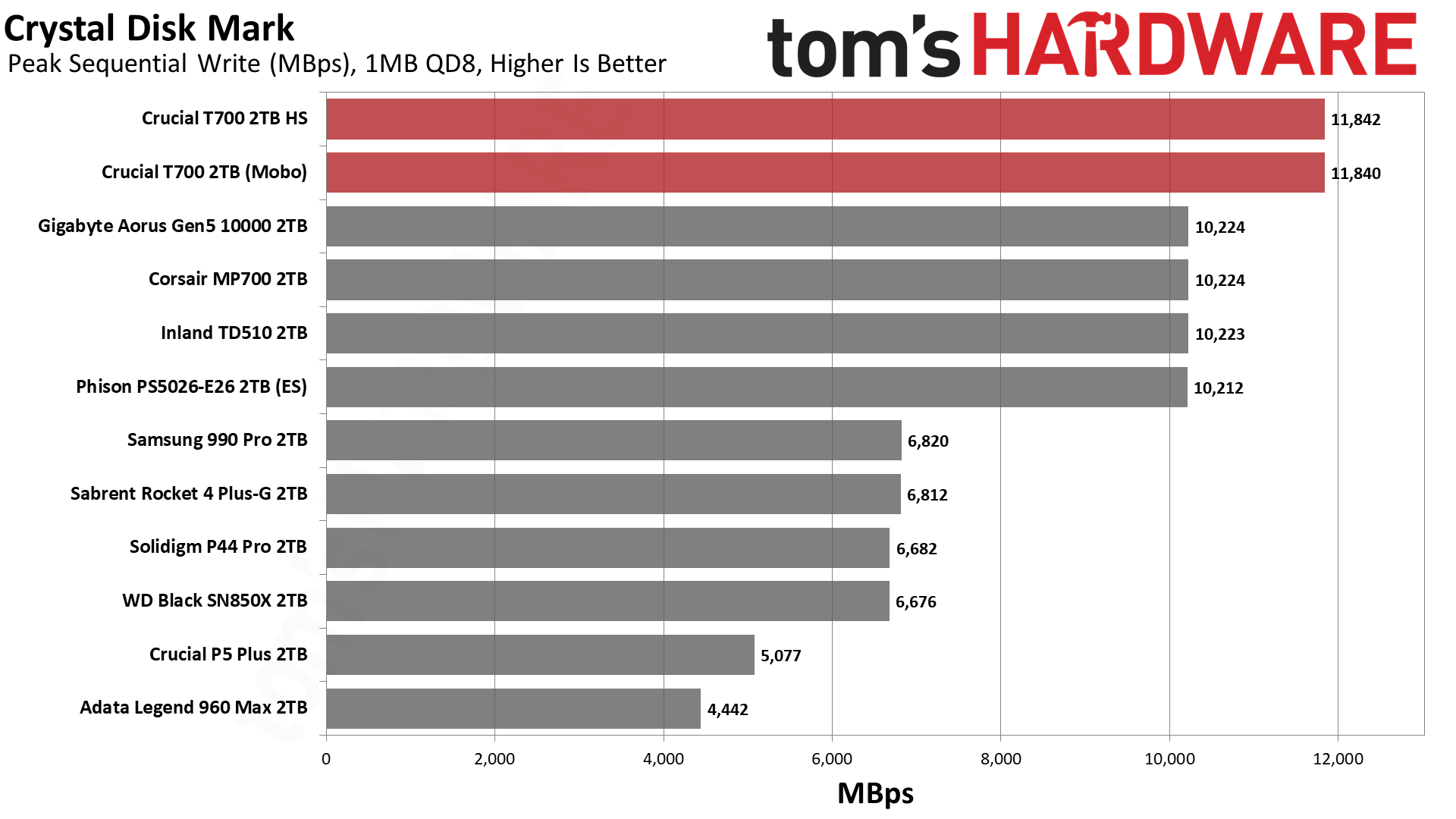
The T700 rules the day in ATTO, particularly as the block size increases past 64KB. There’s a dip at 2MB which, as mentioned in our Crucial T700 Preview, could be a controller quirk or a facet of the flash organization. It's present on the other Phison E26 drives as well for read performance. The T700 also dominates in the CDM sequential results, as expected.
One area the T700 falls short is with random 4KB performance at queue depth 1, still an important result for everyday workloads. In particular, random read latency is critical, and here the T700 comes in second to the Samsung 990 Pro. This is due to Samsung’s 176-Layer TLC having superior read latency. The T700 does do slightly better than previous PCIe 5.0 SSDs, possibly as a small boost from the higher MT/s rate.
Micron’s 232-Layer flash was designed more with density in mind and this may be the case with competing flash to come, which dents the appeal of current 5.0 drives if you’re seeking performance over capacity.
One additional note is that our drives under test are not operating as the primary, or OS, drive. The preview T700 sample had reduced random write performance when used as the primary drive, but this has been fixed for release.
Sustained Write Performance and Cache Recovery
Official write specifications are only part of the performance picture. Most SSDs implement a write cache, which is a fast area of (usually) pseudo-SLC programmed flash that absorbs incoming data. Sustained write speeds can suffer tremendously once the workload spills outside of the cache and into the "native" TLC or QLC flash.
We use Iometer to hammer the SSD with sequential writes for 15 minutes to measure both the size of the write cache and performance after the cache is saturated. We also monitor cache recovery via multiple idle rounds.
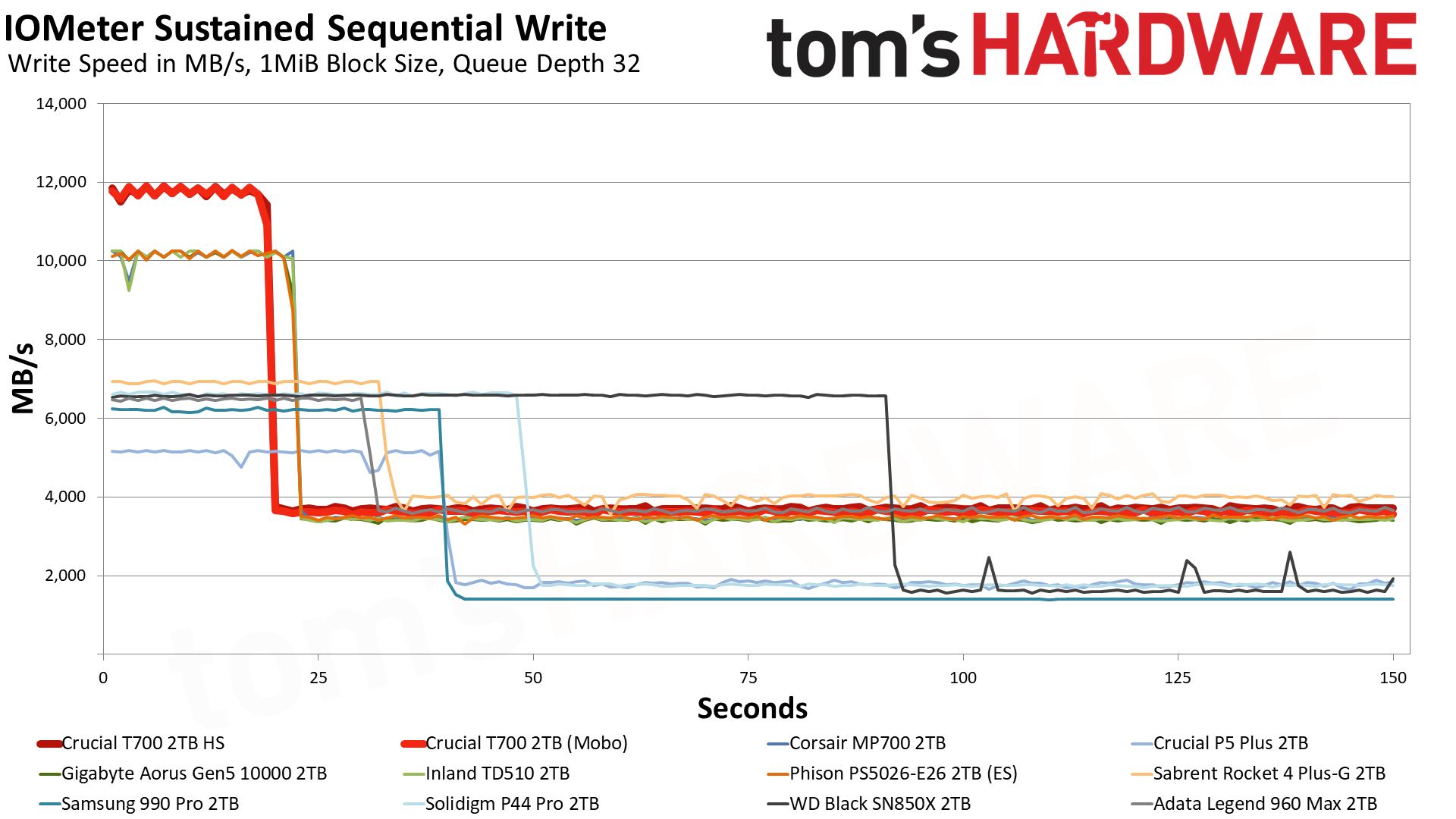

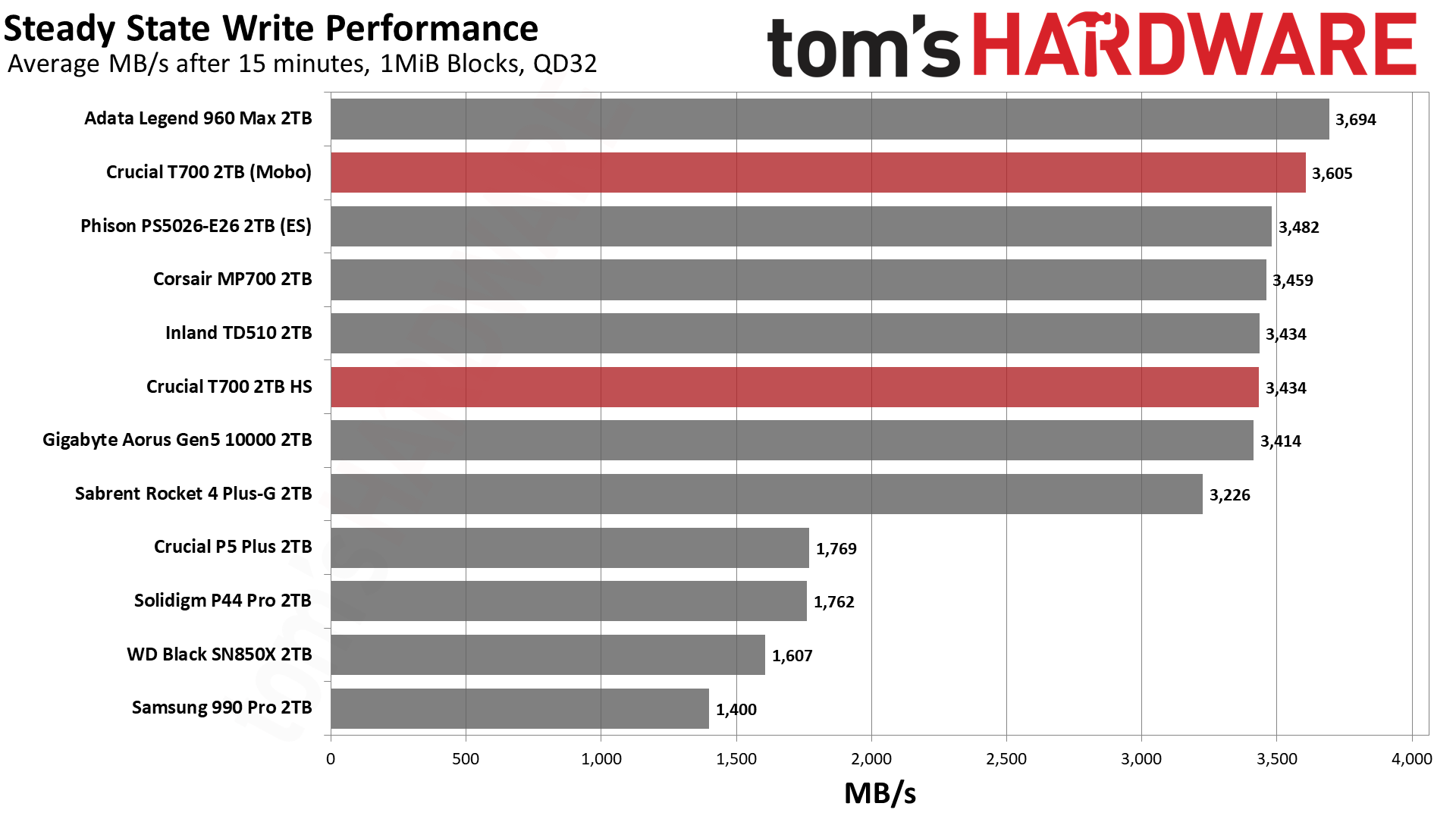
The 2TB T700 writes at up to 12 GBps for over 20 seconds. This matches what Crucial states, which is that about 11% of user capacity is allocated for the dynamic cache. When the drive is empty this is over 220GB from 660GB of SLC, or approximately one-third of the drive’s raw NAND capacity. This is a decently-sized cache to help balance burst and sustained performance even as the drive fills.
The precise pattern of writing will depend on your cooling and the drive’s placement, as demonstrated by the difference between our T700 as native and with a motherboard heatsink. We're testing drives in a PCIe expansion card with the Asus motherboard, and this includes a very large metal cover that serves as a heatsink — far larger than a typical M.2 cooler.
After the cache is exhausted, the T700 writes at around 3.6 GBps in TLC mode. It can maintain this for quite a while before hitting a folding state at around half this speed, and when the cache recovers the drive goes back to TLC. Recovery to TLC performance should be relatively rapid and is adequately fast. This flash should be able to sustain higher levels of TLC performance at 4TB with additional interleaving, but this remains to be seen.
Thermals and Temperatures
We've also begun to collect data on drive temperatures during our DiskBench and Iometer write saturation testing. The latter, as you can imagine, is far more demanding and represents a worst-case scenario. Using the version of the T700 that includes a heatsink during the write saturation testing, it reached a peak temperature of 87C on the controller. At that point, it begins throttling, which is why you see periodic dips in the above write saturation tests around the 850 second mark.
What ends up happening is a short period (less than a second) of reduced performance, then the drive returns to full (saturated) speeds for around 10 seconds. Rinse and repeat until the workload is done.
Please note that this is not a real-world scenario that would normally be encountered by a consumer drive. During our 15 minute stress test, Iometer wrote 2.95 TB of data to the T700. In other words, it more than filled the drive. During the DiskBench testing, where we copy 100GB of files to the drive three times in short succession, drive temperatures peaked at 51C.
Certainly, a larger/heatsink and/or direct active cooling can dramatically drop temperatures. With the large Asus heatsink on the expansion card, peak temperatures during our Iometer testing only reached 54C. This time, due to the lower temperatures and lack of throttling, the T700 drive managed to write just over 3TB of data in nine and a half minutes. The DiskBench tests in this case didn't even break 40C.
Power Consumption
We use a Quarch HD Programmable Power Module to gain a deeper understanding of power characteristics. Idle power consumption is an important aspect to consider, especially if you're looking for a laptop upgrade as even the best ultrabooks can have mediocre storage.
Some SSDs, including all of the PCIe 5.0 SSDs we've tested, can consume a few watts of power at idle while better-suited ones sip just milliwatts. Average workload power consumption and max consumption are two other aspects we'll look at, but performance-per-watt is more important. A drive might consume more power during any given workload, but accomplishing a task faster allows the drive to drop into an idle state more quickly, ultimately saving energy.
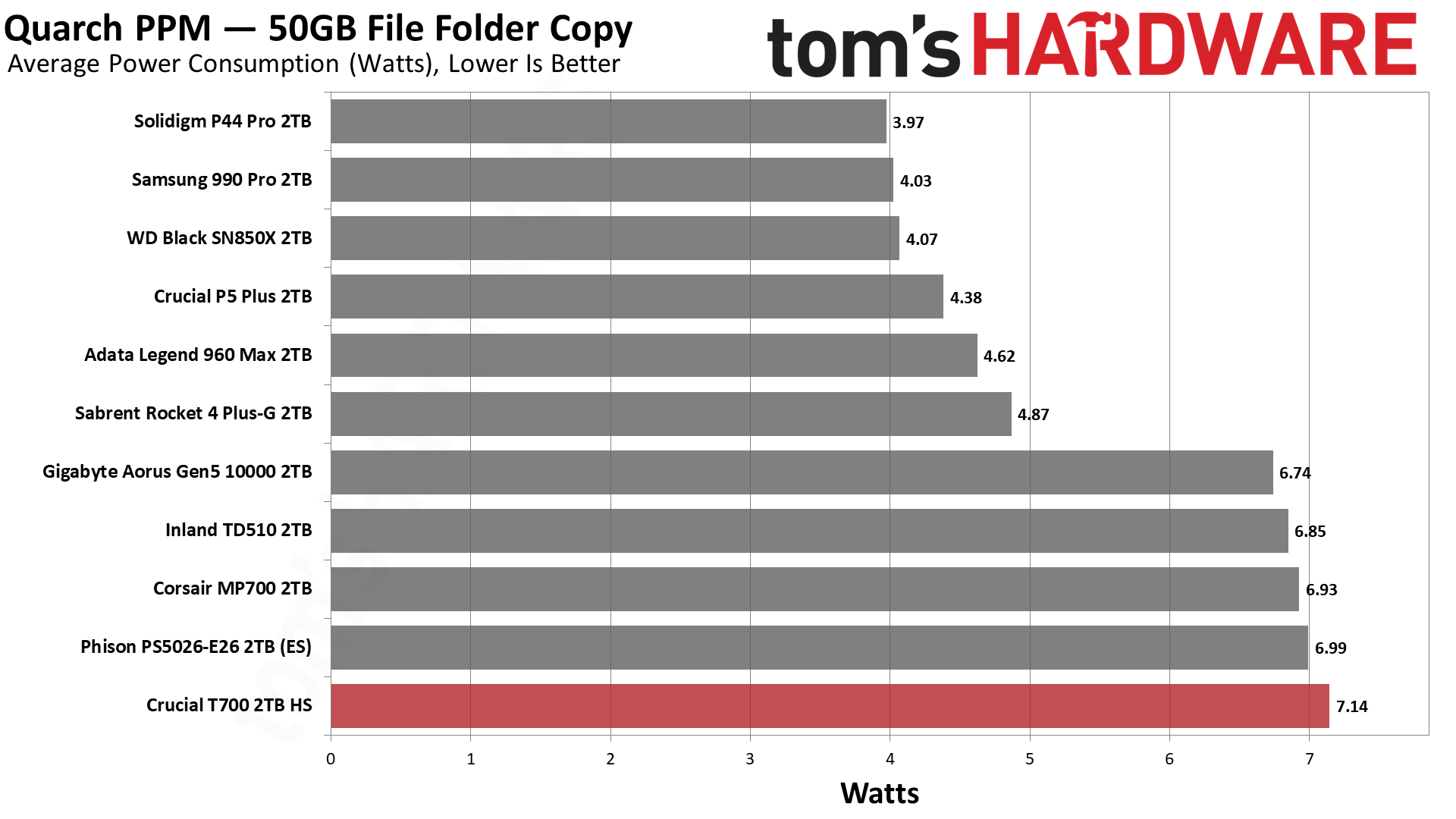
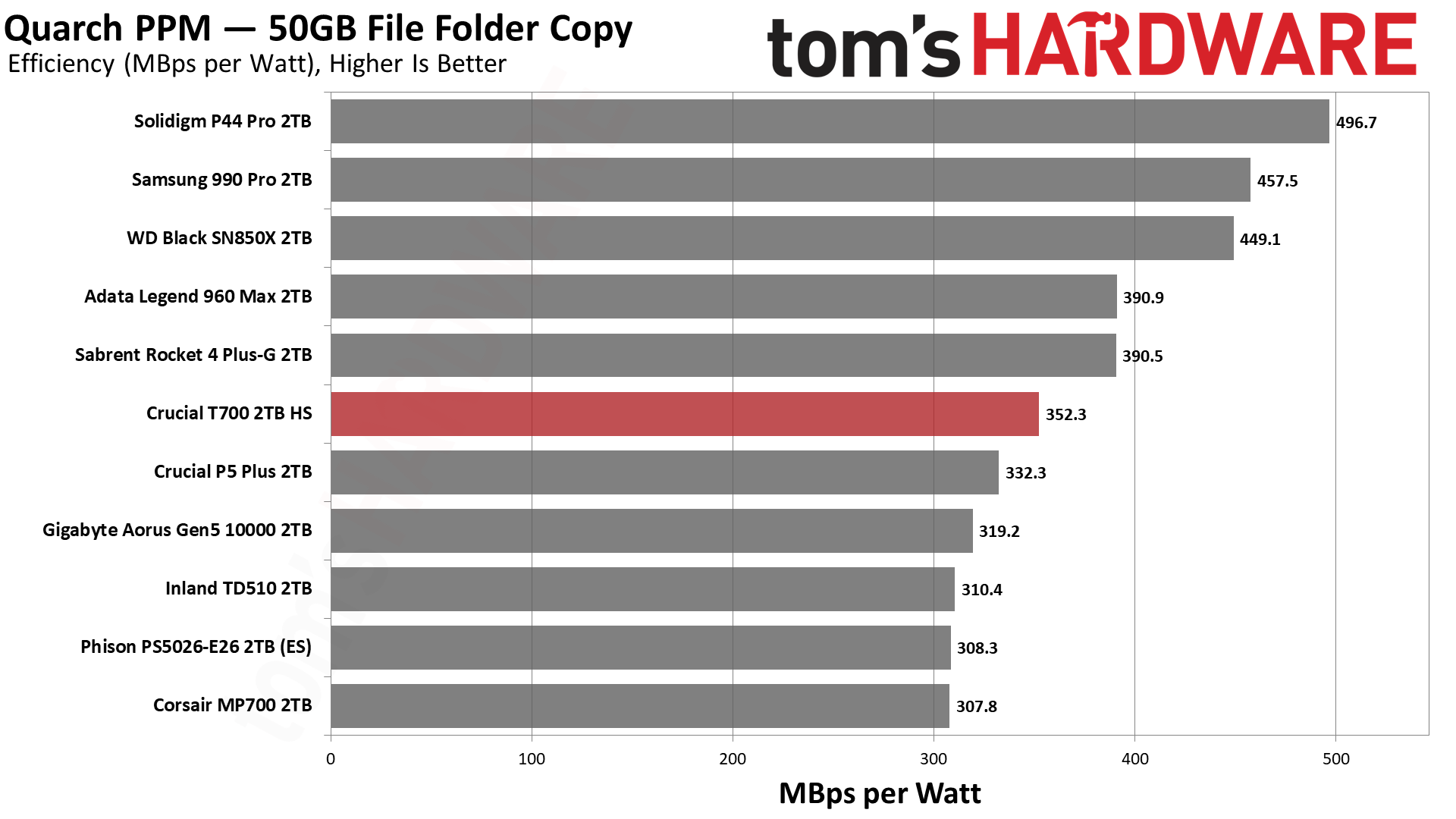
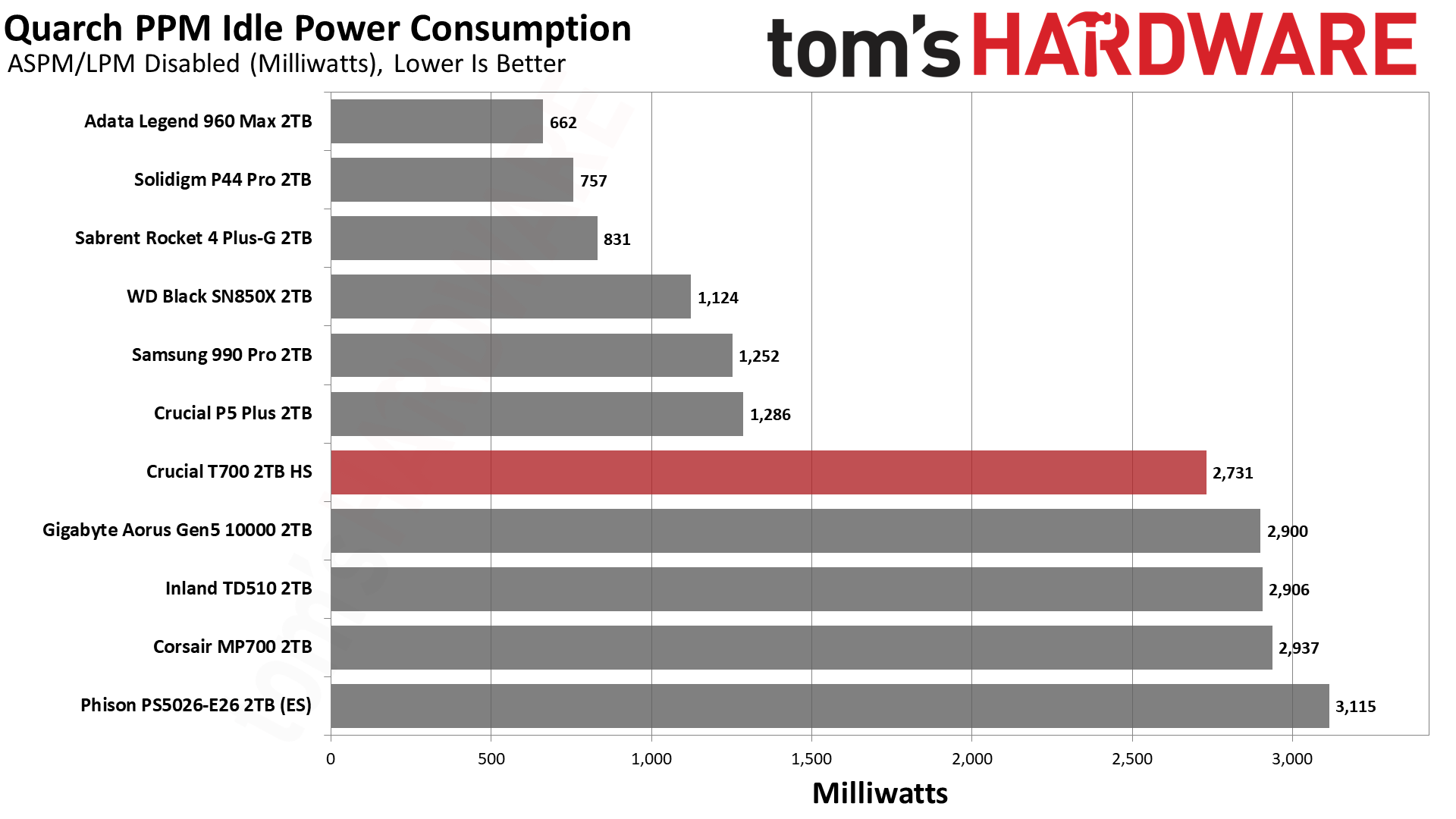
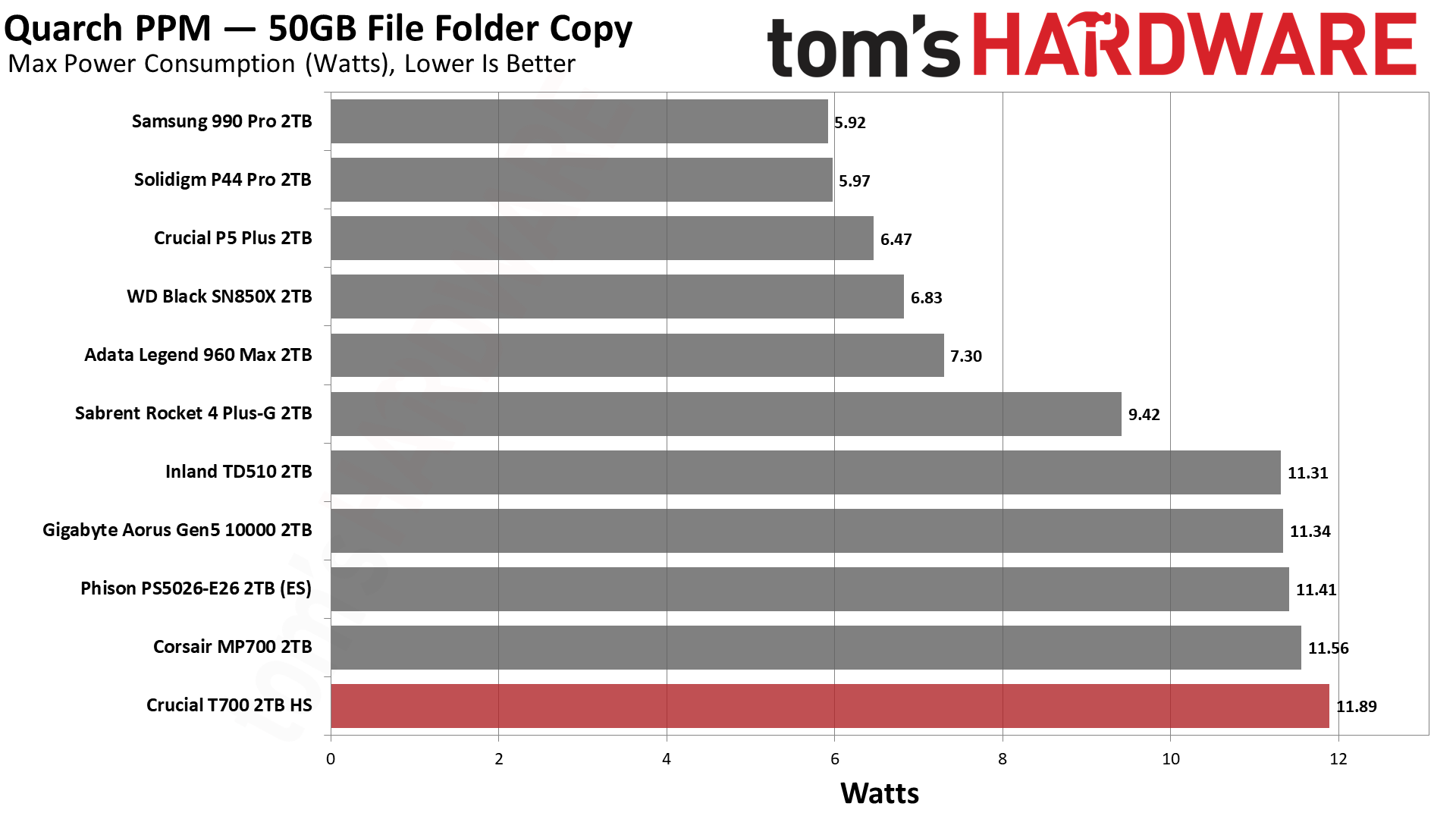
The T700, like the other drives based on the Phison E26 SSD controller, pulls a lot of power. It’s not nearly as efficient as even the fastest PCIe 4.0 drives. This is something that will be ameliorated in time with more efficient controllers and flash. Considering that these 5.0 drives are designed for high-end desktop use only, the issue of power draw is less concerning than it would normally be.
The T700 preview sample had not been optimized for the lowest power states, PS3 and PS4, that is the idle states. This is not a huge factor as the drive should not be making its way into laptops and is hardly a drive you’d choose for a low-power build. Still, the drive at release can use these power states at a typical 85 milliwatts.
Test Bench and Testing Notes
| CPU | Intel Core i9-12900K |
| Motherboard | Asus ROG Maximus Z790 Hero |
| Memory | 2x16GB G.Skill DDR5-5600 CL28 |
| Graphics | Intel Iris Xe UHD Graphics 770 |
| CPU Cooling | Enermax Aquafusion 240 |
| Case | Cooler Master TD500 Mesh V2 |
| Power Supply | Cooler Master V850 i Gold |
| OS Storage | Sabrent Rocket 4 Plus-G 2TB |
| Operating System | Windows 11 Pro |
We use an Alder Lake platform with most background applications such as indexing, Windows updates, and anti-virus disabled in the OS to reduce run-to-run variability. Each SSD is prefilled to 50% capacity and tested as a secondary device. Unless noted, we use active cooling for all SSDs.
Bottom Line
The Crucial T700 is the fastest SSD we’ve tested to date. Some minor wrinkles have been ironed out since our preview, and the drive as a whole produced good results. Drives that are just as fast or even faster have been announced, but this one is available here and now. Crucial has gone to great lengths to offer a decent, passive heatsink, while leaving the option open for you to use your own M.2 cooling solution. This makes it attractive in comparison to existing, slower PCIe 5.0 SSDs that use the reference cooler design with a fan, like the Inland TD510.
The Gigabyte Aorus 10000 also has a heatsink option, albeit with less clearance, but that drive is also slower. If you’re shooting for a drive that comes with a heatsink, however, it is currently $30 less at 2TB than Crucial’s price. If you're looking for a sans-heatsink alternative, the 2TB Corsair MP700 is $40 less than the bare T700, although it may be difficult to find in stock. There should be more options after Computex, especially as we get into August with both pricing and availability expected to improve.
The current outlook divides the PCIe 5.0 SSDs into three rough categories: 10 GBps, ~12 GBps, and ~14 GBps (in the future), all for maximum sequential reads but with boosts to sequential writes possible as well. Directly competing in the middle level with the T700 will be the Team Cardea Z540 and the KLEVV CRAS C950, among others. Faster known drives include the MSI Spatium M570 Pro and ADATA’s Project NeonStorm, as well as the IG5666-based Team Group Z54A. More will certainly be revealed during Computex. Pricing and cooling will differ between these options, but ultimately the lower tiers are early adopter products by design.
As for the PCIe 5.0 selling point a drive like this may have, the performance results speak for themselves: For anything but sequential bandwidth, you should go for a much cheaper PCIe 4.0 SSD. Even on a PCIe 5.0 capable board, getting a drive that performs similarly aside from sequential speeds while being much more efficient makes sense — and many 4.0 drives don't require a heatsink. Furthermore, these early 5.0 drives are as slow as 10 GBps with the T700’s 12 GBps currently the fastest available, neither of which make full use of 5.0 bandwidth.
These SSDs need more time to mature. They can be fun for early adopters and enthusiasts that want to set some records. There's still the possibility of higher capacities, not yet realized, which is also nice. If you are already feeding into that mindset with your build then the premium isn’t that crazy, but if you are not hell-bent on cutting-edge storage you should stick with drives like the Solidigm P44 Pro or WD Black SN850X.
This could influence overall system building decisions, and DirectStorage does not currently have sufficient presence to be a factor if you’ll be upgrading again in a year or two, or even three.
That said, the Crucial T700 is nice for what it is, and it’s important that manufacturers keep pushing the limits. Better products at better prices are a net benefit and encourage market penetration of newer storage hardware, which will hopefully hasten the arrival of DirectStorage-enabled games and applications. The T700 is very fast and we applaud it for that today, but we can’t wait to see better things in the future.
MORE: Best SSDs
MORE: Best External SSDs and Hard Drives
MORE: How We Test HDDs And SSDs
MORE: All SSD Content

Shane Downing is a Freelance Reviewer for Tom’s Hardware US, covering consumer storage hardware.
-
Roland Of Gilead Eh, with the mentioning of heatsinks, it might have been good to include a temp graph!Reply
Just what temps are the drives hitting when they are being tested? -
kiniku A very insightful review of this product and PCI 5.0 NVM-e SSDs relevance today. I just bought a Solidigm P44 2TB for $129.00. This review made me feel even better about my purchase.Reply -
JarredWaltonGPU Reply
I've added details on the temperatures of the drives during testing. This is worst-case write-heavy tests, so Iometer and DiskBench. Iometer wrote 2.95TB during our test sequence that lasts nine and a half minutes, while the larger Asus heatsink managed just over 3 TB of data written.Roland Of Gilead said:Eh, with the mentioning of heatsinks, it might have been good to include a temp graph!
Just what temps are the drives hitting when they are being tested?
For DiskBench, copying 300GB of data to the drive, the Crucial heatsink hit 51C while the Asus heatsink hit 38C. With the sustained write saturation testing, the Crucial heatsink peaked at 87C, which is the throttling point. Then it would slow down for a second (less than a second?) and the drive would stay in the 85~86C range. -
harleyspawn I would like to have seen a benchmark of this drive but connected to a PCIe 4.0 slot; just to get a good idea of how it would perform in a recent (but not bleeding-edge) motherboard. If it's got performance on-par with the leading PCIe 4.0 drives, then it may make sense to get this drive while waiting for the next must-have upgrade to the motherboard/CPU. If it's going to perform like a mid-tier PCIe 4.0 drive, then it makes sense to go with a top-tier PCIe 4.0 drive instead of this one if you're going to keep using something like an AMD 5000-series or Intel 11th or 12th gen CPU for a few more years.Reply -
JarredWaltonGPU Reply
We could limit the PCIe slot to Gen4 speeds. But why? This drive costs over twice as much as a top-tier Gen4 drive of similar capacity. If you don't have a Gen5 slot, there's no reason to buy it. Latency isn't better, random QD1 performance isn't better, and power consumption is far higher. It's all about the raw bandwidth.harleyspawn said:I would like to have seen a benchmark of this drive but connected to a PCIe 4.0 slot; just to get a good idea of how it would perform in a recent (but not bleeding-edge) motherboard. If it's got performance on-par with the leading PCIe 4.0 drives, then it may make sense to get this drive while waiting for the next must-have upgrade to the motherboard/CPU. If it's going to perform like a mid-tier PCIe 4.0 drive, then it makes sense to go with a top-tier PCIe 4.0 drive instead of this one if you're going to keep using something like an AMD 5000-series or Intel 11th or 12th gen CPU for a few more years.
You'd be far better off buying a good Gen4 drive, and then if/when you upgrade your motherboard to something that supports PCIe 5.0 drives, you could probably buy a future Gen5 drive for the same price as the Gen4 drive, and still come out ahead. That's what I'd recommend doing.
If it were a case of spending maybe 20% more for the potential upgrade in the future, yes, that might be worth considering. But when we're looking at $340 for the 2TB model, and the Samsung 990 Pro 2TB costs half that, or the Solidigm P44 Pro 2TB goes for $130? It just doesn't make much sense without a Gen5 platform to run the SSD. We can only hope that the PCIe 5.0 price premium comes way down in the near future, because as fast as this drive is, it's not worth more than $200 in my book. -
Amdlova I use a pci4 ssd on pci 3 speed. And what I got? Pci 3 speeds but the highest temp with out a huge heat sink is 54°c. The motherboard works on 40°c or more. Have poor to none ventilation on the case. But these new pci5 it's too hot for most users. I want my fan cases spinning at 490 550 rpm little noise to none These ssds will fryReply -
Roland Of Gilead Reply
Dang! They get hot! Will be active cooling on them in no time, if not already!JarredWaltonGPU said:I've added details on the temperatures of the drives during testing. This is worst-case write-heavy tests, so Iometer and DiskBench. Iometer wrote 2.95TB during our test sequence that lasts nine and a half minutes, while the larger Asus heatsink managed just over 3 TB of data written.
For DiskBench, copying 300GB of data to the drive, the Crucial heatsink hit 51C while the Asus heatsink hit 38C. With the sustained write saturation testing, the Crucial heatsink peaked at 87C, which is the throttling point. Then it would slow down for a second (less than a second?) and the drive would stay in the 85~86C range.
I get that these are temps at the higher end though. -
JarredWaltonGPU Reply
Do note that the Inland TD510 has a tiny little fan to help cool it down. The Corsair MP700 originally was going to have a similar design, but ended up dropping the heatsink and fan option. (Probably because the fan sucked and wasn't a great experience. I have one of those original drives!) The new "solution" is that you just need a big heatsink on it.Roland Of Gilead said:Dang! They get hot! Will be active cooling on them in no time, if not already!
I get that these are temps at the higher end though. -
Sleepy_Hollowed This is not bad, I'd have a hard time buying this though since I don't see anywhere on their spec sheet power loss protection (crucial's higher end stuff used to have pretty decent protection).Reply
But if you don't need that it's up there for the ones needing the speed.
Their drives have been solid for me on both mobile and desktop, and they even used to (not sure if still do) offer a RAM caching system with their software to speed things up even more on some workloads, if you have enough RAM. -
g-unit1111 Replykiniku said:A very insightful review of this product and PCI 5.0 NVM-e SSDs relevance today. I just bought a Solidigm P44 2TB for $129.00. This review made me feel even better about my purchase.
Yeah I just bought the SK Hynix P41 Platinum for my new rig, and I'm glad I didn't decide to pay 3x the price for not a whole lot gained in SSD performance.
